Sonicwall 034 TA 170 User Manual SonicOS Standard
Sonicwall, Inc. TA 170 SonicOS Standard
Contents
- 1. Users Manual Part 1
- 2. Users Manual Part 2
- 3. Users Manual Part 3
- 4. Users Manual Part 4
- 5. Users Manual Part 5
Users Manual Part 4
Page 22 SonicWALL SonicOS Standard Administrator’s Guide
Detection Prevention
Enable Stealth Mode
By default, the SonicWALL responds to incoming connection requests as either “blocked” or “open”. If you
enable Stealth Mode, your SonicWALL does not respond to blocked inbound connection requests.
Stealth Mode makes your SonicWALL essentially invisible to hackers.
Randomize IP ID
Select Randomize IP ID to prevent hackers using various detection tools from detecting the presence of
a SonicWALL appliance. IP packets are given random IP IDs which makes it more difficult for hackers to
“fingerprint” the SonicWALL appliance.
Dynamic Ports
•Select Enable support for Oracle (SQLNet) if you have Oracle applications on your network.
•Select Enable Support for Windows Messenger if you are having problems using Windows Mes-
senger and Windows XP through the SonicWALL. If Enable Support for Windows Messenger is
selected, it may affect the performance of the SonicWALL.
•Select Enable SIP Transformations to transform SIP messaging from the LAN to the WAN. If the
SIP proxy is located on the WAN and the SIP clients are on the LAN, the SIP clients use their private
IP address in the SIP Session Definition Protocol (SDP) sent to the SIP proxy. Since the IP addresses
are unchanged, the SIP proxy cannot return messages to the SIP client. By enabling SIP transforma-
tions on the SonicWALL, the appliance changes the private address and port in the SDP to the public
address and port. The SIP transformation also controls and opens the RTP/RTCP ports to allow SIP
sessions.
•Select Enable H.323 Transformations for H.323 protocol-aware packet content inspection and mod-
ification by the SonicWALL. The SonicWALL performs any dynamic IP address and transport port
mapping, within the H.323 packet, necessary for communication between H.323 parties on the LAN
and WAN.
•Select Enable RTSP Transformations to support on-demand delivery of real-time data, such as au-
dio and video. RTSP (Real Time Streaming Protocol) is an application-level protocol for control over
delivery of data with real-time properties.
Source Routed Packets
Drop Source Routed Packets is selected by default. Clear the check box if you are testing traffic
between two specific hosts and you are using source routing.
TCP Connection Inactivity Timeout
If a connection to a remote server remains idle for more than five minutes, the SonicWALL closes the
connection. Without this timeout, Internet connections could stay open indefinitely, creating potential
security holes. You can increase the Inactivity Timeout if applications, such as Telnet and FTP, are
frequently disconnected.
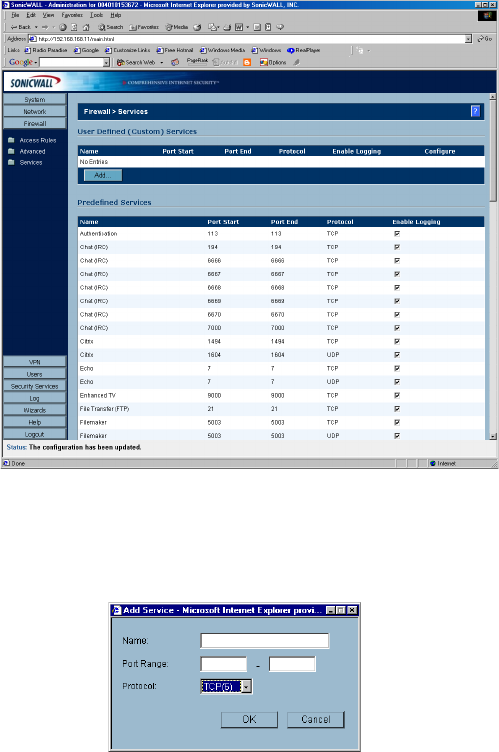
Firewall Page 23
Firewall>Services
Services are anything a server provides to other computers. A service can be as simple as the computer
asking a server for the correct time (NTP) and the server returns a response. Other types of services
provide access to different types of data. Web servers (HTTP) respond to requests from clients (browser
software) for access to files and data. Services are used by the SonicWALL to configure network access
rules for allowing or denying traffic to the network.
User Defined (Custom) Services
If protocol is not listed in the Predefined Services table, you can add it to the User Defined (Custom)
Services table by clicking Add.
1. Enter the name of the service in the Name field.
2. Enter the port number or numbers that apply to the service. A list of well know port numbers can be
found in any networking reference.
3. Select the type of protocol, TCP, UDP, or ICMP from the Protocol menu.
4. Click OK. The service appears in the User Defined (Custom) Services table.
Page 24 SonicWALL SonicOS Standard Administrator’s Guide
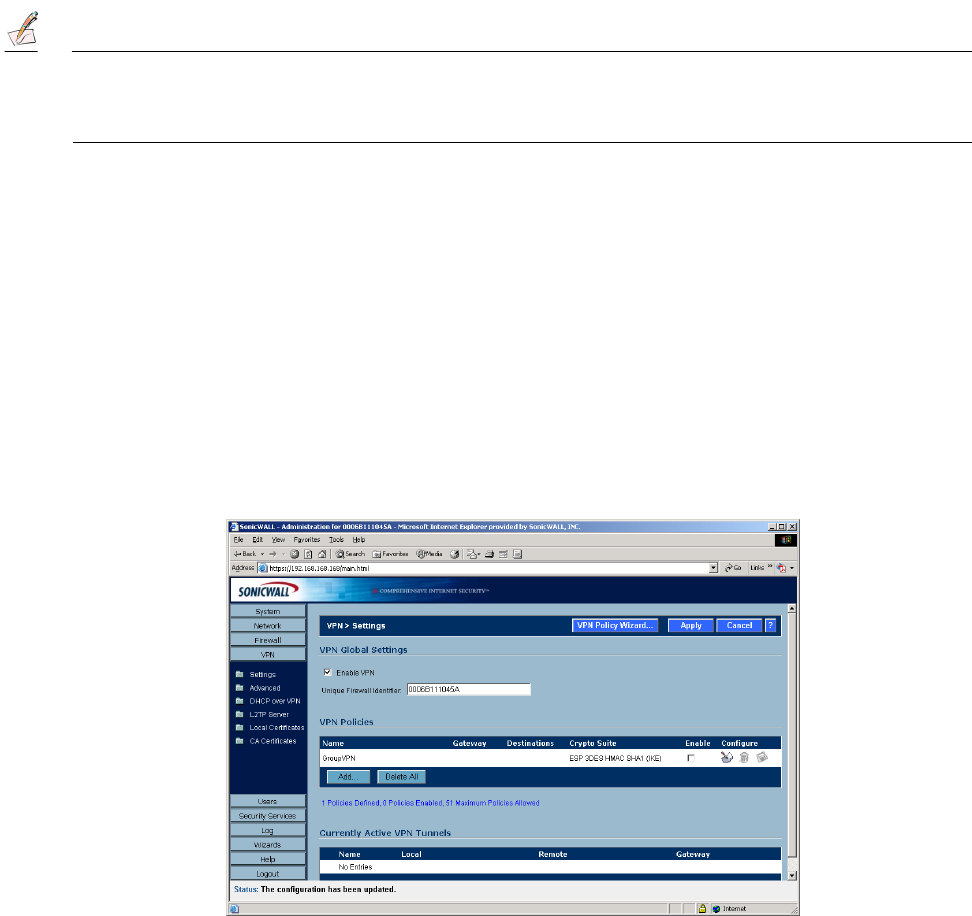
VPN Page 25
9 VPN
SonicWALL VPN provides an easy-to-setup, secure solution for connecting mobile users, telecommuters,
remote offices and partners via the Internet. Mobile users, telecommuters, and other remote users with
broadband (DSL or cable) or dialup Internet access can securely and easily access your network
resources with the SonicWALL Global VPN Client or Global Security Client and SonicWALL GroupVPN
on your SonicWALL.
Note:
For more information on the SonicWALL Global VPN Client, see the SonicWALL Global VPN Client
Administrator’s Guide. For more information on the SonicWALL Global Security Client, see the
SonicWALL Global Security Client Administrator’s Guide.
Remote office networks can securely connect to your network using site-to-site VPN connections that
enable network-to- network VPN connections.
Using the SonicWALL intuitive Management Interface, you can quickly create a VPN Security Association
(SA) to a remote site. Whenever data is intended for the remote site, the SonicWALL automatically
encrypts the data and sends it over the Internet to the remote site, where it is decrypted and forwarded to
the intended destination.
SonicWALL VPN is based on the industry-standard IPSec VPN implementation, therefore, it is
interoperable with other VPN products.
VPN>Settings
The VPN>Settings page provides the SonicWALL features for configuring your site-to-site VPN and your
VPN client to SonicWALL VPN policies.
VPN Global Settings
The Global VPN Settings section displays the following information:
•Enable VPN must be selected to allow VPN policies through the SonicWALL.
•Unique Firewall Identifier - the default value is the serial number of the SonicWALL. You can change
the Identifier, and use it for configuring VPN tunnels.
Page 26 SonicWALL SonicOS Standard Administrator’s Guide
VPN Policies
All existing VPN policies are displayed in the VPN Policies table. Each entry displays the following
information:
•Name - user-defined name to identify the Security Association.
•Gateway - the IP address of the remote SonicWALL. If 0.0.0.0 is used, no Gateway is displayed.
•Destinations - the IP addresses of the destination networks.
•Crypto Suite - the type of encryption used
•Enable - selecting the check box enables the VPN Policy. Clearing the check box
disables it.
• Configure - edit or delete the VPN Policy information. GroupVPN has a Disk icon for
exporting the configuration for SonicWALL Global VPN Clients.
The number of VPN policies defined, policies enabled, and the maximum number of Policies allowed is
displayed below the table.
Currently Active VPN Tunnels
A list of currently active VPN tunnels is displayed in this section. The table lists the name of the VPN
Policy, the local LAN IP addresses, and the remote destination network IP addresses as well as the Peer
Gateway IP address.
Configuring GroupVPN Policy on the SonicWALL
SonicWALL VPN defaults to a Group VPN setting. This feature facilitates the set up and deployment of
multiple VPN clients by the administrator of the SonicWALL. Security settings can now be exported to the
remote client and imported into the remote VPN client settings. Group VPN allows for easy deployment
of multiple VPN clients making it unnecessary to individually configure remote VPN clients. Group VPN
is only available for VPN clients and it is recommended to use XAUTH/RADIUS or third party certificates
in conjunction with the Group VPN for added security.
The default GroupVPN configuration allows you to support SonicWALL Global VPN Clients without any
further editing of the VPN policy, except to check the Enable box for GroupVPN in the VPN Policies table.
You can choose from IKE using Preshared Secret or IKE using 3rd Party Certificates for your IPSec
Keying Mode.
Configuring IKE using Preshared Secret
To edit the default settings for Group VPN, follow these steps:

VPN Page 27
1. Click the Notepad icon in the Group VPN entry. The VPN Policy window is displayed.
General
2. In the General tab, IKE using Preshared Secret is the default setting for IPSec Keying Mode. A
Shared Secret is automatically generated in the Shared Secret field, or you can generate your own
shared secret. Shared Secrets must be minimum of four characters.
Proposals
3. Click the Proposals tab to continue the configuration process.
In the IKE (Phase 1) Proposal section, select the following settings:
Group 2 from the DH Group menu.
3DES from the Encryption menu
SHA1 from the Authentication menu
Leave the default setting, 28800, in the Life Time (secs) field. This setting forces the tunnel to
renegotiate and exchange keys every 8 hours.
In the IPSec (Phase 2) Proposal section, select the following settings:
ESP from the Protocol menu
3DES from the Encryption menu
MD5 from the Authentication menu
Select Enable Perfect Forward Secrecy if you want an additional Diffie-Hellman key exchange as
an added layer of security. Then select Group 2 from the DH Group menu.
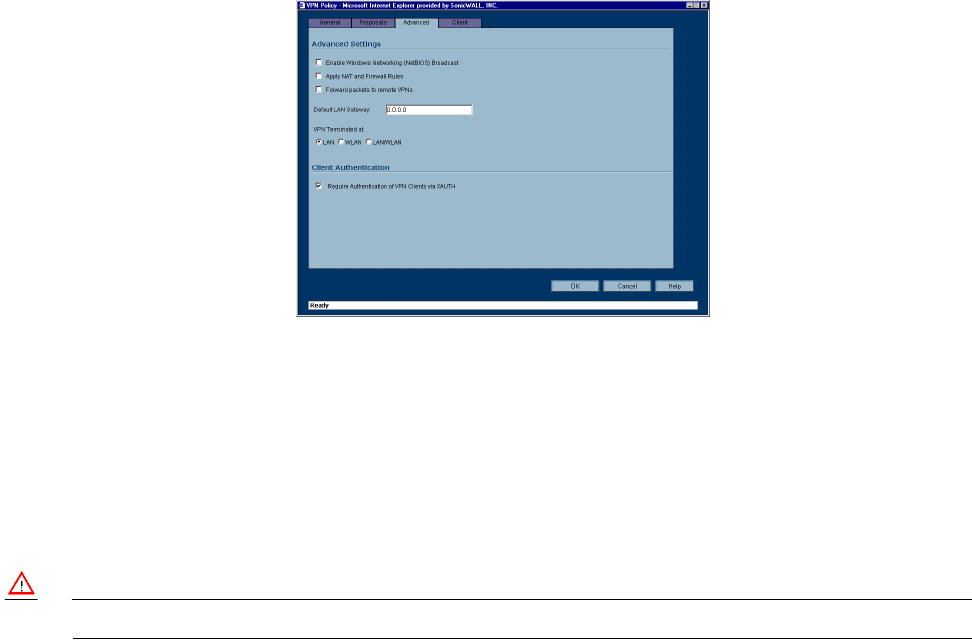
Page 28 SonicWALL SonicOS Standard Administrator’s Guide
Leave the default setting, 28800, in the Life Time (secs) field. This setting forces the tunnel to
renegotiate and exchange keys every 8 hours.
Advanced
4. Click the Advanced tab. Select any of the following settings you want to apply to your GroupVPN
policy.
• Enable Windows Networking (NetBIOS) broadcast - to allow access to remote network resources
by browsing the Windows® Network Neighborhood.
•Apply NAT and Firewall Rules - This feature allows a remote site’s LAN subnet to be hidden from
the corporate site, and is most useful when a remote office’s network traffic is initiated to the corporate
office. The IPSec tunnel is located between the SonicWALL WAN interface and the LAN segment of
the corporation. To protect the traffic, NAT (Network Address Translation) is performed on the
outbound packet before it is sent through the tunnel, and in turn, NAT is performed on inbound
packets when they are received. By using NAT for a VPN connection, computers on the remote LAN
are viewed as one address (the SonicWALL public address) from the corporate LAN.
Alert!
Offices can have overlapping LAN IP ranges if the Apply NAT and Firewall Rules feature is selected.
•Forward Packets to Remote VPNs - allows the remote VPN tunnel to participate in the SonicWALL
routing table. Inbound traffic is decrypted and can be forwarded to a remote site via another VPN
tunnel. Normally, inbound traffic is decrypted and only forwarded to the SonicWALL LAN or a specific
route on the LAN configured on the Routing page located in the Network section. Enabling this
feature allows a network administrator to create a “hub and spoke” network configuration by
forwarding inbound traffic to a remote site via a VPN security association. To create a “hub and spoke”
network, select the Forward Packets to Remote VPNs check box.Traffic can travel from a branch
office to a branch office via the corporate office.
•Default LAN Gateway - used at a central site in conjunction with a remote site using Use this VPN
Tunnel as default route for all Internet traffic. Default LAN Gateway allows the network adminis-
trator to specify the IP address of the default LAN route for incoming IPSec packets for this SA. In-
coming packets are decoded by the SonicWALL and compared to static routes configured in the
SonicWALL. Since packets can have any IP address destination, it is impossible to configure enough
static routes to handle the traffic. For packets received via an IPSec tunnel, the SonicWALL looks up
a route for the LAN. If no route is found, the SonicWALL checks for a Default LAN Gateway. If a De-
fault LAN Gateway is detected, the packet is routed through the gateway. Otherwise, the packet is
dropped.
•VPN Terminated at the LAN, OPT/DMZ, or LAN/OPT/DMZ - Selecting this option allows you to
terminate a VPN tunnel on a specific destination instead of allowing the VPN tunnel to terminate on
the entire SonicWALL network. By terminating the VPN tunnel to a specific destination, the VPN
tunnel has access to a specific portion of the destination LAN or OPT/DMZ network.
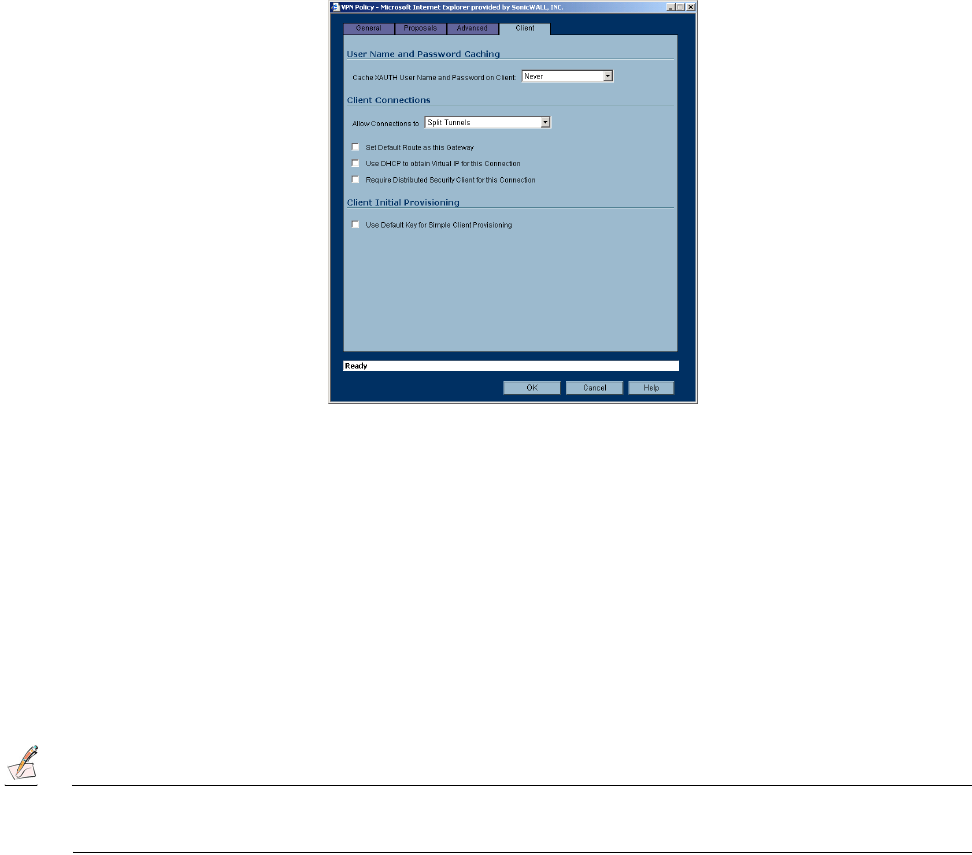
VPN Page 29
•Require Authentication of VPN Clients via XAUTH - requires that all inbound traffic on this SA is
from an authenticated user. Unauthenticated traffic is not allowed on the VPN tunnel.
Client
5. Click the Client tab. Select any of the following settings you want to apply to your GroupVPN policy.
•Cache XAUTH User Name and Password - allows the Global VPN Client to cache the user name
and password. Select from Single Session (default), Never, or Always.
•Allow Connections - Client network traffic matching destination networks of each gateway is sent
through the VPN tunnel of that specific gateway. Select from Split Tunnels, This Gateway Only, or
All Secured Gateways.
• Set Default Route as this Gateway - Enable this check box if all remote VPN connections access
the Internet through this VPN Policy. You can only configure one VPN Policy to use this setting.
• Use DHCP to obtain Virtual IP for this Connection - allows the VPN Client to obtain an IP address
using DHCP over VPN.
•Require Distributed Security Client for this Connection - only allows a VPN
connection from a remote computer running the SonicWALL Distributed Security Client, which pro-
vides policy enforced firewall protection before allowing a Global VPN Client connection.
Note:
For more information on the SonicWALL Global Security Client and Distributed Security Client, see the
SonicWALL Global Security Client Administrator’s Guide.
•Use Default Key for Simple Client Provisoning - the initial Aggressive mode exchange by the gate-
way and VPN clients uses a default Preshared Key for authentication.
6. Click OK.

Page 30 SonicWALL SonicOS Standard Administrator’s Guide
Configuring GroupVPN with IKE using 3rd Party Certificates
To configure your GroupVPN policy with IKE using 3rd Party Certificates, follow these steps:
Alert!
Before configuring GroupVPN with IKE using 3rd Party Certificates, your certificates must be installed
on the SonicWALL.
1. In the VPN>Settings page click the Notepad icon under Configure. The VPN Policy window is
displayed.
General
2. In the Security Policy section, select IKE using 3rd Party Certificates from the IPSec Keying
Mode menu. The SA name is Group VPN by default and cannot be changed.
3. Select a certificate for the SonicWALL from the Gateway Certificate menu.
4. Select one of the following Peer ID types from the Peer ID Type menu.
E-Mail ID
Distinguished name
Domain name
5. Enter the Peer ID filter in the Peer ID Filter field.
6. Check All Only Peer Certificates Signed by Gateway Issuer to specify that peer certificates must
be signed by the issuer specified in the Gateway Certificate menu.
Proposals
7. Click on the Proposals tab.
8. In the IKE (Phase 1) Proposal section, select the following settings:
Group 2 from the DH Group menu.
3DES from the Encryption menu.
SHA1 from the Authentication menu.
Leave the default setting, 28800, in the Life Time (seconds) field. This setting forces the tunnel to
renegotiate and exchange keys every 8 hours.
9. In the IPSec (Phase 2) Proposal section, select the following settings:
ESP from the Protocol menu.
3DES from the Encryption menu.
MD5 from the Authentication menu.
Select Enable Perfect Forward Secrecy if you want an additional Diffie-Hellman key exchange as
an added layer of security. Then select Group 2 from the DH Group menu.
Leave the default setting, 28800, in the Life Time (seconds) field. This setting forces the tunnel to
renegotiate and exchange keys every 8 hours.
Advanced
Click on the Advanced tab and select any of the following optional settings that you want to apply to your
GroupVPN policy:
Enable Windows Networking (NetBIOS) broadcast - to allow access to remote network resources
by browsing the Windows Network Neighborhood.
VPN Page 31
Apply NAT and Firewall Rules - This feature allows a remote site’s LAN subnet to be hidden from
the corporate site, and is most useful when a remote office’s network traffic is initiated to the corporate
office. The IPSec tunnel is located between the SonicWALL WAN interface and the LAN segment of
the corporation. To protect the traffic, NAT (Network Address Translation) is performed on the
outbound packet before it is sent through the tunnel, and in turn, NAT is performed on inbound
packets when they are received. By using NAT for a VPN connection, computers on the remote LAN
are viewed as one address (the SonicWALL public address) from the corporate LAN. If the
SonicWALL uses the Transparent Mode network configuration, using this check box applies the
firewall access rules and checks for attacks, but not does not apply NAT.
Forward Packets to Remote VPNs - allows the remote VPN tunnel to participate in the SonicWALL
routing table. Inbound traffic is decrypted and can be forwarded to a remote site via another VPN
tunnel. Normally, inbound traffic is decrypted and only forwarded to the SonicWALL LAN or a specific
route on the LAN configured on the Routing page located in the Network section. Enabling this feature
allows a network administrator to create a “hub and spoke” network configuration by forwarding
inbound traffic to a remote site via a VPN security association. To create a “hub and spoke” network,
select the Forward Packets to Remote VPNs check box. Traffic can travel from a branch office to a
branch office via the corporate office.
Default LAN Gateway - used at a central site in conjunction with a remote site using the Route all
Internet traffic through this SA check box. Default LAN Gateway allows the network administrator to
specify the IP address of the default LAN route for incoming IPSec packets for this SA. Incoming
packets are decoded by the SonicWALL and compared to static routes configured in the SonicWALL.
Since packets can have any IP address destination, it is impossible to configure enough static routes
to handle the traffic. For packets received via an IPSec tunnel, the SonicWALL looks up a route for
the LAN. If no route is found, the SonicWALL checks for a Default LAN Gateway. If a Default LAN
Gateway is detected, the packet is routed through the gateway. Otherwise, the packet is dropped.
VPN Terminated at the LAN, DMZ/OPT, or LAN/DMZ/OPT - Selecting this option allows you to
terminate a VPN tunnel on a specific destination instead of allowing the VPN tunnel to terminate on
the entire SonicWALL network. By terminating the VPN tunnel to a specific destination, the VPN
tunnel has access to a specific portion of the destination LAN or DMZ/OPT network.
Require Authentication of VPN Clients via XAUTH - requires that all inbound traffic on this SA is
from an authenticated user. Unauthenticated traffic is not allowed on the VPN tunnel.
Client
10. Click on the Client tab and select any of the following boxes that you want to apply to Global VPN
Client provisioning:
Cache XAUTH User Name and Password - Allows Global VPN Client to cache any username and
password required for XAUTH user authentication. The drop-down list provides the following options:
Never - Global VPN Client is not allowed to cache username and password. The user will be
prompted for a username and password when the connection is enabled and also every time
there is an IKE phase 1 rekey.
Single Session - The user will be prompted for username and password each time the
connection is enabled and will be valid until the connection is disabled. This username and
password is used through IKE phase 1 rekey.
Always - The user will be prompted for username and password only once when connection is
enabled. When prompted, the user will be given the option of caching the username and
password.
Client Connections
Allow Traffic to - Specifies single or multiple VPN connections. The drop-down list provides the
following options:

Page 32 SonicWALL SonicOS Standard Administrator’s Guide
This Gateway Only - Allows a single connection to be enabled at a time. Traffic that matches the
destination networks as specified in the policy of this gateway is sent through the VPN tunnel. All
other traffic is blocked. If this option is selected along with Set Default Route as this Gateway,
then the Internet traffic is also sent through the VPN tunnel. If this option is selected without
selecting Set Default Route as this Gateway, then the Internet traffic is blocked.
All Secured Gateways - Allows one or more connections to be enabled at the same time. Traffic
matching the destination networks of each gateway is sent through the VPN tunnel of that specific
gateway. If this option is selected along with Set Default Route as this Gateway, then Internet
traffic is also sent through the VPN tunnel. If this option is selected without selecting Set Default
Route as this Gateway, then the Internet traffic is blocked. Only one of the multiple gateways can
have Set Default Route as this Gateway enabled.
Split Tunnels - Allows the VPN user to have both local Internet access and VPN connectivity.
Set Default Route as this Gateway - If checked, Global VPN Client traffic that does not match
selectors for the gateway’s protected subnets must also be tunnelled. In effect, this changes the
Global VPN Client’s default gateway to the gateway tunnel endpoint. If unchecked, the Global VPN
Client must drop all non-matching traffic if Allow traffic to This Gateway Only or All Secured Gateways
is selected.
Use DHCP to Obtain Virtual IP for this Connection - If set, this allows the Global VPN Client to
obtain the IP address and other attributes like DNS and WINS from an external DHCP server on the
LAN side of the gateway.
Require Distributed Security Client for this Connection - Allows a VPN connection from the
remote Global Security Client only if the remote computer is running the SonicWALL Distributed
Security Client, which provides policy enforced firewall protection.
Use Default Key for Simple Client Provisioning - If set, authentication of initial Aggressive mode
exchange uses a default Preshared Key by gateway and all Global VPN Clients. This allows for the
control of the use of the default registration key. If not set, then Preshared Key must be distributed
out of band.
13. Click OK.
14. Click Apply to enable the changes.
Export a GroupVPN Client Policy
If you want to export the Global VPN Client configuration settings to a file for users to import into their
Global VPN Clients, follow these instructions:
Alert!
The GroupVPN SA must be enabled on the SonicWALL to export a configuration file.
1. Click the Disk icon under Configure for the GroupVPN policy. The Export VPN Client Policy
window is displayed.
2. rcf format is required for SonicWALL Global Clients is selected by default. Files saved in the rcf
format can be password encrypted.
3. Click Yes. The VPN Policy Export window is displayed.
4. If you want to encrypt the exported file, type a password in the Password field, re-enter the password
in the Confirm Password field, and then click Submit.
5. If you do not want the exported file encrypted, click Submit. A message appears confirming your
choice. Click OK.
6. Select the locations to save the file and click Save.
7. Click Close.
VPN Page 33
The file can be saved to a floppy disk or sent electronically to remote users to configure their Global VPN
Clients.
Site to Site VPN Configurations
When designing VPN connections, be sure to document all pertinent IP Addressing information and
create a network diagram to use as a reference. A sample planning sheet is provided on the next page.
The SonicWALL must have a routable WAN IP Address whether it is dynamic or static.
Be sure that the networks behind the SonicWALLs are unique. The same subnets cannot reside behind
two different VPN gateways.
In a VPN network with dynamic and static IP addresses, the VPN gateway with the dynamic address must
initiate the VPN connection.
Site to Site VPN Configurations can include the following options:
•Branch Office (Gateway to Gateway) - A SonicWALL is configured to connect to another Son-
icWALL via a VPN tunnel. Or, a SonicWALL is configured to connect via IPSec to another manufac-
turer’s firewall.
•Hub and Spoke Design - All SonicWALL VPN gateways are configured to connect to a central Son-
icWALL (hub), such as a corporate SonicWALL. The hub must have a static IP address, but the
spokes can have dynamic IP addresses. If the spokes are dynamic, the hub must be a SonicWALL.
•Mesh Design - All sites connect to all other sites. All sites must have static IP addresses.
Page 34 SonicWALL SonicOS Standard Administrator’s Guide
VPN Planning Sheet for Site-to-Site VPN Policies
You need the information below before you begin configuring Site-to-Site VPN Policies.
Site A
Workstation
LAN IP Address: ___.___.___.___
Subnet Mask: ___.___.___.___
Default Gateway: ___.___.___.___
SonicWALL
LAN IP Address: ___.___.___.___
WAN IP Address: ___.___.___.___
Subnet Mask: ___.___.___.___
Default Gateway: ___.___.___.___
Router
Internet Gateway
WAN IP Address: ___.___.___.___
Subnet Mask: ___.___.___.___
DNS Server #1: ___.___.___.___
DNS Server #2: ___.___.___.___
Additional Information
SA Name:____________________
Manual Key, SPI In_____ SPI Out_____
Enc.Key:____________________
Auth.Key:___________________
If Preshared Secret,
Shared Secret:___________________
Phase 1 DH - 1 2 5
SA Lifetime 28800 or ____________
Phase 1 Enc/Auth DES 3DES AES-128 AES-256 MD5 SHA1 (circle)
Phase 2 Enc/Auth DES 3DES AES-128 AES-256 MD5 SHA1 (circle)
ARC NULL

VPN Page 35
Configuring Site to Site VPN Policies
Using the VPN Policy Wizard
The VPN Policy Wizard quickly and easily walks you through the steps of configuring a VPN security
policy between two SonicWALL appliances.
The VPN Policy Wizard allows you to create a Typical VPN connection. Using this option, the wizard
creates a VPN policy based on IKE using Preshared Secret.
Using the Custom option in the VPN Policy Wizard allow you to create a VPN policy with your own
configuration options based on one of the following IPSec Keying Modes:
• IKE using Preshared Secret
• Manual Key
• IKE using 3rd Party Certificates
Note:
You need IP addressing information for your local network as well as your remote network. Use the VPN
Planning Sheet to record your information.
Creating a Typical IKE using Preshared Secret VPN Policy
You can create a Typical VPN Policy using the VPN Policy Wizard to configure an IPSec VPN security
association between two SonicWALL appliances.
1. Click VPN Policy Wizard on the VPN>Settings page to launch the wizard. Click Next.
2. Select Typical and click Next.
3. Enter a name for the policy in the Policy Name field. You may want to use the name of a remote office
or other identifying feature so that it is easily identified. Enter the IP address or Fully Qualified Domain
Name of the remote destination in the IPSec Gateway Name or Address field. Click Next.
4. Enter the IP address of the network protected by the remote SonicWALL in the Remote Network
field. This is a private IP address on the remote network. Enter the subnet mask in the Remote
Netmask field. Click Next.
5. Enter a shared secret in the Shared Secret field. Use a combination of letters and numbers to create
a unique secret. Click Next.
6. To enable the VPN policy immediately, click Apply. If you prefer to disable the policy initially, select
Create this Policy Disabled, and then click Apply.
Creating a Custom VPN Policy using IKE and a Preshared Secret
To create a custom VPN policy using IKE and a Preshared Secret, follow these steps:
1. Click VPN Policy Wizard to launch the wizard. Click Next to continue.
2. Select Custom, and click Next.
3. Enter a name for the policy in the Policy Name field. You may want to use the name of a remote office
or other identifying feature so that it is easily identified. Enter the IP address or Fully Qualified Domain
Name of the remote destination in the IPSec Gateway Name or Address field. Click Next.
4. Enter the IP address of the network protected by the remote SonicWALL in the Remote Network
field. This is a private IP address on the remote network. Enter the subnet mask in the Remote
Netmask field. Click Next.

Page 36 SonicWALL SonicOS Standard Administrator’s Guide
Note:
You can add additional networks by editing the VPN policy after it is created in the VPN Policy Wizard.
5. Select IKE using Preshared Secret as the IPSec Keying Mode. Click Next.
6. Enter a shared secret in the Shared Secret field. Use a combination of letters and numbers to create
a unique secret. Click Next.
7. Select from the DH Group menu. Diffie-Hellman (DH) key exchange (a key agreement protocol) is
used during phase 1 of the authentication process to establish pre-shared keys. To compromise
between network speed and network security, select Group 2.
Select an encryption method from the Encryption list for the VPN tunnel. If network speed is
preferred, then select DES. If network security is preferred, select 3DES. To compromise between
network speed and network security, select DES.
Select an authentication method from the Authentication list. SHA1 is preferred for network security.
Keep the default value of 28800 (8 hours) as the Life Time (seconds) for the VPN Policy. Click Next.
8. Select ESP from the Protocol menu. ESP is more secure than AH, but AH requires less processing
overhead.
Select 3DES from the Encryption menu. 3DES is extremely secure and recommended for use.
Select SHA1 from the Authentication menu.
Select Enable Perfect Forward Secrecy. The Enable Perfect Forward Secrecy check box
increases the renegotiation time of the VPN tunnel. By enabling Perfect Forward Secrecy, a hacker
using brute force to break encryption keys is not able to obtain other or future IPSec keys. During the
phase 2 renegotiation between two SonicWALL appliances or a Group VPN SA, an additional Diffie-
Hellman key exchange is performed. Enable Perfect Forward Secrecy adds incremental security
between gateways.
If Enable Perfect Forward Secrecy is enabled, select the type of Diffie-Hellman (DH) Key Exchange
(a key agreement protocol) to be used during phase 2 of the authentication process to establish pre-
shared keys.
Leave the default value, 28800, in the Life Time (seconds) field. The keys renegotiate every 8 hours.
Click Next.
9. To enable the VPN policy immediately, click Apply. If you prefer to disable the policy initially, select
Create this Policy Disabled, and then click Apply.
Creating a Manual Key VPN Policy with the VPN Policy Wizard
You can create a custom VPN Policy using the VPN Wizard to configure a different IPSec method or
configure more advanced features for the VPN Policy.
1. Click VPN Policy Wizard to launch the wizard. Click Next to continue.
2. Select Custom, and click Next.
3. Enter a name for the policy in the Policy Name field. You may want to use the name of a remote office
or other identifying feature so that it is easily identified. Enter the IP address or Fully Qualified Domain
Name of the remote destination in the IPSec Gateway Name or Address field. Click Next.
4. Enter the IP address of the network protected by the remote SonicWALL in the Remote Network
field. This is a private IP address on the remote network. Enter the subnet mask in the Remote
Netmask field. Click Next.

VPN Page 37
Note:
You can add additional networks by editing the VPN policy after it is created in the VPN Policy Wizard.
5. Select Manual Key from the IPSec Keying Modes list. Click Next.
6. Define an Incoming SPI and an Outgoing SPI. The SPIs are hexadecimal (0123456789abcedf) and
can range from 3 to 8 characters in length. Or use the default values.
Alert!
Each Security Association must have unique SPIs; no two Security Associations can share the same
SPIs. However, each Security Association Incoming SPI can be the same as the Outgoing SPI.
ESP is selected by default from the Protocol menu. ESP is more secure than AH, but AH requires
less processing overhead.
3DES is selected by default from the Encryption Method menu. Enter a 48-character hexadecimal
key if you are using 3DES encryption.Enter a 16-character hexadecimal key in the Encryption Key
field if you are using DES or ARCFour encryption. This encryption key must match the remote
SonicWALL's encryption key.
The default 48-character key is a unique key generated every time a VPN Policy is created.
AH is selected by default from the Authentication Key field. When a new SA is created, a 32-
character key is automatically generated in the Authentication Key field. This key can be used as a
valid key. If this key is used, it must also be entered in the Authentication Key field in the remote
SonicWALL. If authentication is not used, this field is ignored.
Click Next.
7. To enable the VPN policy immediately, click Apply. If you prefer to disable the policy initially, select
Create this Policy Disabled, and then click Apply.
Configuring IKE using 3rd Party Certificates with the VPN Policy Wizard
Alert!
You must have a valid certificate from a third party Certificate Authority installed on your SonicWALL
before you can configure your VPN policy with IKE using a third party certificate. See “Digital
Certificates” on page 55 for more information.
1. Click VPN Policy Wizard to launch the wizard. Click Next to continue.
2. Select Custom, and click Next.
3. Enter a name for the policy in the Policy Name field. You may want to use the name of a remote office
or other identifying feature so that it is easily identified. Enter the IP address or Fully Qualified Domain
Name of the remote destination in the IPSec Gateway Name or Address field. Click Next.
4. Enter the IP address of the network protected by the remote SonicWALL in the Remote Network
field. This is a private IP address on the remote network. Enter the subnet mask in the Remote
Netmask field. Click Next.
5. Select IKE using 3rd Party Certificates from the IPSec Keying Modes list. Click Next.
6. Select your third party certificate from the Third Party Certificate menu. Select the ID type from the
Peer Certificate’s ID Type, and enter the ID string in the ID string to match field. Click Next.
7. Select from the DH Group menu. Diffie-Hellman (DH) key exchange (a key agreement protocol) is
used during phase 1 of the authentication process to establish pre-shared keys. To compromise
between network speed and network security, select Group 2.

Page 38 SonicWALL SonicOS Standard Administrator’s Guide
Select an encryption method from the Encryption list for the VPN tunnel. If network speed is
preferred, then select DES. If network security is preferred, select 3DES. To compromise between
network speed and network security, select DES.
Select an authentication method from the Authentication list. SHA1 is preferred for network security.
Leave the default value of 28800 (8 hours) as the Life Time (seconds) for the VPN Policy.
Click Next.
8. ESP is selected by default from the Protocol menu. ESP is more secure than AH, but AH requires
less processing overhead.
3DES is selected by default from the Encryption menu. Enter a 48-character hexadecimal key if you
are using 3DES encryption.Enter a 16-character hexadecimal key in the Encryption Key field if you
are using DES or ARCFour encryption. This encryption key must match the remote SonicWALL's
encryption key.
The default 48-character key is a unique key generated every time a VPN Policy is created.
AH is selected by default from the Authentication Key field. When a new SA is created, a 32-
character key is automatically generated in the Authentication Key field. This key can be used as a
valid key. If this key is used, it must also be entered in the Authentication Key field in the remote
SonicWALL. If authentication is not used, this field is ignored.
Click Next.
9. To enable the VPN policy immediately, click Apply. If you prefer to disable the policy initially, select
Create this Policy Disabled, and then click Apply.
Creating VPN Policies Using the VPN Policy Window
You can create or modify existing VPN policies using the VPN Policy window. Clicking the Add button
under the VPN Policies table displays the VPN Policy window for configuring the following IPSec Keying
mode VPN policies:
• IKE using Preshared Key
• Manual Key
• IKE using 3rd Party Certificates
Tip!
You can create these policies using the VPN Policy Wizard.
Configuring a VPN Policy using IKE with Preshared Secret
To manually configure a VPN Policy using IKE with Preshared Secret, follow the steps below:
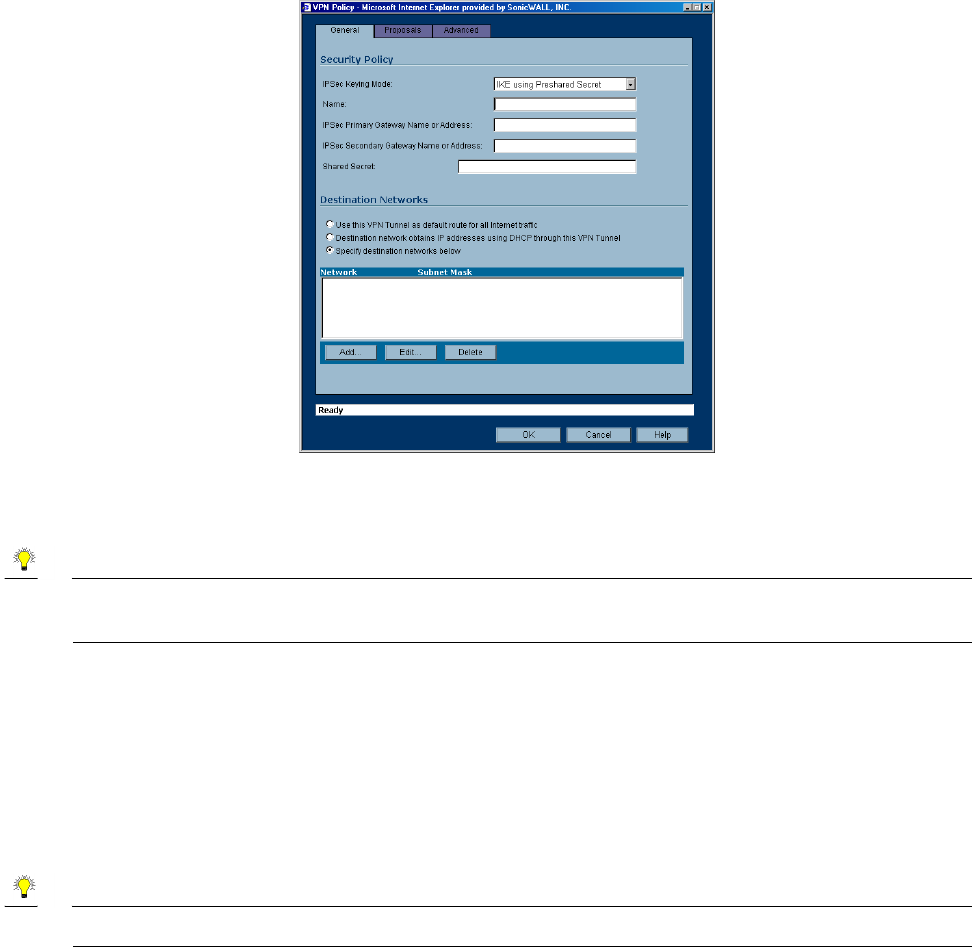
VPN Page 39
1. In the VPN>Settings page, click Add. The VPN Policy window is displayed.
2. In the General tab, IKE using Preshared Secret is selected by default from the IPSec Keying Mode
menu.
Tip!
Use the VPN worksheet in this chapter to record your settings. These settings are necessary to
configure the remote SonicWALL and create a successful VPN connection.
3. Enter a name for the VPN Policy in the Name field.
4. Enter the IP address or gateway name of the REMOTE SonicWALL in the IPSec Primary Gateway
Name or Address field.
5. If you have a second IP address or gateway name, enter it in the IPSec Secondary Gateway Name
or Address field. If the primary gateway is unavailable, the SonicWALL uses the second gateway to
create the VPN tunnel.
6. Enter a combination of letters, symbols, and numbers as the Shared Secret in the Shared Secret
field.
Tip!
The Shared Secret must be a minimum of four characters.
7. Choose from the following options in the Destination Networks section:
•Use this VPN Tunnel as the default route for all Internet traffic - select this option if all remote
VPN connections access the Internet through this SA. You can only configure one SA to use this
option.
•Destination network obtains IP addresses using DCHP through this SA - select this option if you
are managing your network IP address allocation from a central location.
•Specify destination networks below - configure the remote destination network for your SA. Click
Add to add the IP address and subnet mask. You can modify existing destination networks by click
Edit, and delete networks by selecting the network and clicking Delete.

Page 40 SonicWALL SonicOS Standard Administrator’s Guide
8. Click the Proposals tab
9. In the IKE (Phase 1) Proposal section, the default settings offer a secure connection configuration,
however, the settings can be modified to reflect your preferences. In addition to 3DES, AES-128,
AES-192, and AES-256 can be selected for encryption methods.
10. In the Ipsec (Phase 2) Proposal section, the default settings offer a secure connection configuration,
however, the settings can be modified to reflect your preferences. In addition to 3DES, AES-128,
AES-192, and AES-256 can be selected for encryption methods. Selecting Enable Perfect Forward
Secrecy prevents a hacker using brute force to break encryption keys from obtaining the current and
future IPSec keys. During Phase 2 negotiation, an additional Diffie-Hellman key exchange is
performed. This option adds an additional layer of security to the VPN tunnel.
11. Click the Advanced tab. Select any optional configuration options you want to apply to your VPN
policy in the Advanced Settings section.
• Enable Keep Alive - Select this setting if you want to maintain the current connection by listening for
traffic on the network segment between the two connections. If multiple VPN tunnels are configured
on the SonicWALL, select Try to bring up all possible tunnels to have the SonicWALL renegotiate
the tunnels if they lose communication with the
SonicWALL.
•Require authentication of local users - requires all outbound VPN traffic from this SA is from an
authenticated source.
•Require authentication of remote users - requires all inbound VPN traffic for this SA is from an au-
thenticated user. Select Remote users behind VPN gateway if remote users have a VPN tunnel that
terminates on the VPN gateway. Select Remote VPN clients with XAUTH if remote users require
authentication using XAUTH and are access the SonicWALL via a VPN clients.
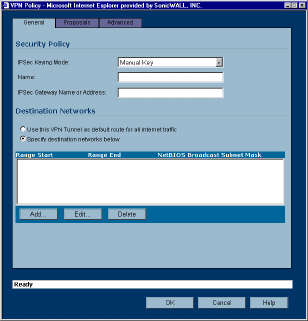
VPN Page 41
•Enable Windows Networking (NetBIOS) broadcast - to allow access to remote
network resources by browsing the Windows® Network Neighborhood.
•Apply NAT and Firewall Rules - This feature allows a remote site’s LAN subnet to be hidden from
the corporate site, and is most useful when a remote office’s network traffic is initiated to the corporate
office. The IPSec tunnel is located between the SonicWALL WAN interface and the LAN segment of
the corporation. To protect the traffic, NAT
(Network Address Translation) is performed on the outbound packet before it is sent through the tun-
nel, and in turn, NAT is performed on inbound packets when they are
received. By using NAT for a VPN connection, computers on the remote LAN are viewed as one ad-
dress (the SonicWALL public address) from the corporate LAN.
•Forward Packets to Remote VPNs - allows the remote VPN tunnel to participate in the SonicWALL
routing table. Inbound traffic is decrypted and can be forwarded to a remote site via another VPN tun-
nel. Normally, inbound traffic is decrypted and only forwarded to the SonicWALL LAN or a specific
route on the LAN configured on the Routing page located in the Network section. Enabling this fea-
ture allows a network administrator to create a “hub and spoke” network configuration by forwarding
inbound traffic to a remote site via a VPN security association. To create a “hub and spoke” network,
select the Forward Packets to Remote VPNs check box.Traffic can travel from a branch office to a
branch office via the corporate office.
•Default LAN Gateway - used at a central site in conjunction with a remote site using the Route all
internet traffic through this SA check box. Default LAN Gateway allows the network administrator to
specify the IP address of the default LAN route for incoming IPSec packets for this SA. Incoming pack-
ets are decoded by the SonicWALL and compared to static routes configured in the SonicWALL.
Since packets can have any IP address destination, it is impossible to configure enough static routes
to handle the traffic. For packets received via an IPSec tunnel, the SonicWALL looks up a route for
the LAN. If no route is found, the SonicWALL checks for a Default LAN Gateway. If a Default LAN
Gateway is detected, the packet is routed through the gateway. Otherwise, the packet is dropped.
•VPN Terminated at the LAN, OPT/DMZ, or LAN/OPT/DMZ - Selecting this option allows you to ter-
minate a VPN tunnel on a specific destination instead of allowing the VPN tunnel to terminate on the
entire SonicWALL network. By terminating the VPN tunnel to a specific destination, the VPN tunnel
has access to a specific portion of the destination LAN or OPT/DMZ network.
12. Click OK. Your new VPN policy is displayed in the VPN Policies table.
Configuring a VPN Policy using Manual Key
To manually configure a VPN Policy in the VPN Policy window using Manual Key, follow the steps below:
1. In the VPN>Settings page, click Add. The VPN Policy window is displayed.
2. Select Manual Key from the IPSec Keying Mode menu.
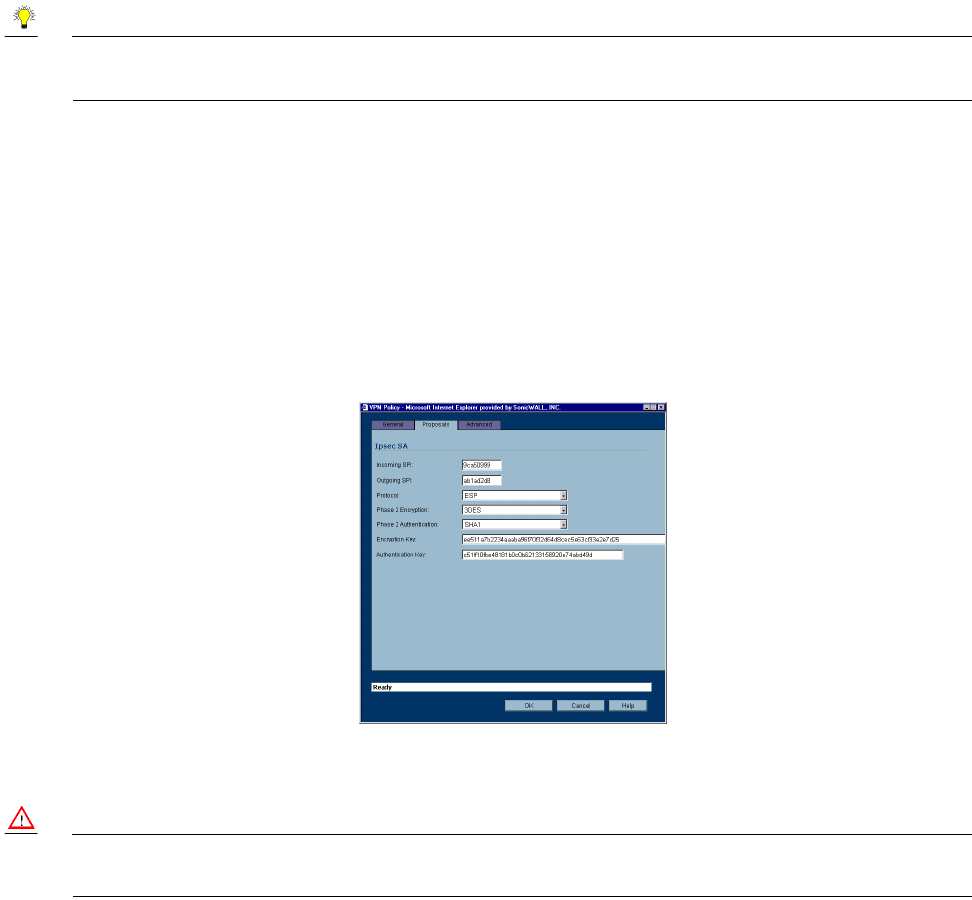
Page 42 SonicWALL SonicOS Standard Administrator’s Guide
Tip!
Use the VPN worksheet at the beginning of this chapter to record your settings. These settings are
necessary to configure the remote SonicWALL and create a successful VPN connection.
3. In the Security Policy section, enter a name for the VPN Policy in the Name field.
4. Enter the IP address or gateway name of the REMOTE SonicWALL in the IPSec Gateway Name or
Address field.
5. In the Destination Networks section, one of the following options:
•Use this SA as the default route for all Internet traffic - select this option if all remote VPN connec-
tions access the Internet through this SA. You can only configure one SA to use this option.
•Specify destination networks below - configure the remote destination network for your SA. Click
Add to add the IP address and subnet mask. You can modify existing destination networks by click
Edit, and delete networks by selecting the network and clicking Delete.
6. Click on the Proposals tab.
7. In the Ipsec SA section, define an Incoming SPI and an Outgoing SPI. The SPIs are hexadecimal
(0123456789abcedf) and can range from 3 to 8 characters in length. Or use the default values.
Alert!
Each Security Association must have unique SPIs; no two Security Associations can share the same
SPIs. However, each Security Association Incoming SPI can be the same as the Outgoing SPI.
8. ESP is selected by default from the Protocol menu. ESP is more secure than AH, but AH requires
less processing overhead.
9. 3DES is selected by default from the Phase 2 Encryption menu. Enter a 48-character hexadecimal
key if you are using 3DES encryption.Enter a 16-character hexadecimal key in the Encryption Key
field if you are using DES or ARCFour encryption. This encryption key must match the remote
SonicWALL's encryption key.
The default 48-character key is a unique key generated every time a VPN Policy is created.
10. SHA1 is selected by default from the Phase 2 Authentication menu. When a new Policy is created,
a 32-character key is automatically generated in the Authentication Key field. This key can be used
as a valid key. If this key is used, it must also be entered in the Authentication Key field in the remote
SonicWALL. If authentication is not used, this field is ignored.
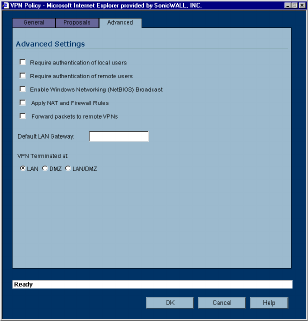
VPN Page 43
11. Click on the Advanced tab. Select the optional configuration settings you want to apply to your VPN
policy from the Advanced Settings section.
• Require authentication of local users - requires all outbound VPN traffic from this SA is from an
authenticated source.
• Require authentication of remote users - requires all inbound VPN traffic for this SA is from an au-
thenticated user.
•Enable Windows Networking (NetBIOS) broadcast - to allow access to remote network resources
by browsing the Windows® Network Neighborhood.
•Apply NAT and Firewall Rules - This feature allows a remote site’s LAN subnet to be hidden from
the corporate site, and is most useful when a remote office’s network traffic is initiated to the corporate
office. The IPSec tunnel is located between the SonicWALL WAN interface and the LAN segment of
the corporation. To protect the traffic, NAT (Network Address Translation) is performed on the out-
bound packet before it is sent through the tunnel, and in turn, NAT is performed on inbound packets
when they are received. By using NAT for a VPN connection, computers on the remote LAN are
viewed as one address (the SonicWALL public address) from the corporate LAN.
•Forward Packets to Remote VPNs - allows the remote VPN tunnel to participate in the SonicWALL
routing table. Inbound traffic is decrypted and can be forwarded to a remote site via another VPN tun-
nel. Normally, inbound traffic is decrypted and only forwarded to the SonicWALL LAN or a specific
route on the LAN configured on the Routing page located in the Network section. Enabling this fea-
ture allows a network administrator to create a “hub and spoke” network configuration by forwarding
inbound traffic to a remote site via a VPN security association. To create a “hub and spoke” network,
select the Forward Packets to Remote VPNs check box.Traffic can travel from a branch office to a
branch office via the corporate office.

Page 44 SonicWALL SonicOS Standard Administrator’s Guide
•Default LAN Gateway - used at a central site in conjunction with a remote site using the Use this
VPN Tunnel as the default route for all internet traffic. Default LAN Gateway allows the network
administrator to specify the IP address of the default LAN route for incoming IPSec packets for this
VPN Policy. Incoming packets are decoded by the SonicWALL and compared to static routes config-
ured in the SonicWALL. Since packets can have any IP address destination, it is impossible to con-
figure enough static routes to handle the traffic. For packets received via an IPSec tunnel, the
SonicWALL looks up a route for the LAN. If no route is found, the SonicWALL checks for a Default
LAN Gateway. If a Default LAN Gateway is detected, the packet is routed through the gateway. Oth-
erwise, the packet is dropped.
•VPN Terminated at the LAN, OPT/DMZ, or LAN/OPT/DMZ - Selecting this option allows you to ter-
minate a VPN tunnel on a specific destination instead of allowing the VPN tunnel to terminate on the
entire SonicWALL network. By terminating the VPN tunnel to a specific destination, the VPN tunnel
has access to a specific portion of the destination LAN or OPT/DMZ network.
12. Click OK to add the Manual Key VPN Policy to the SonicWALL.
Configuring a VPN Policy with IKE using a Third Party Certificate
Alert!
You must have a valid certificate from a third party Certificate Authority installed on your SonicWALL
before you can configure your VPN policy with IKE using a third party certificate. See “Digital
Certificates” on page 55 for more information.
To create a VPN SA using IKE and third party certificates, follow these steps:
1. In the VPN>Settings page, click Add. The VPN Policy window is displayed.
2. In General tab, select IKE using 3rd Party Certificates.
3. Type a Name for the Security Association in the Name field.
4. Type the IP address or Fully Qualified Domain Name (FQDN) of the primary remote SonicWALL in
the IPSec Primary Gateway Name or Address field. If you have a secondary remote SonicWALL,
enter the IP address or Fully Qualified Domain Name (FQDN) in the IPSec Secondary Gateway
Name or Address field.
5. Select a certificate from the Third Party Certificate menu.
6. Select Distinguished name, E-Mail ID, or Domain name from the Peer Certificate’s ID Type menu.
7. Type an ID string in the ID string to match field.
8. In the Destination Network section, select one of the following options:
Use this VPN Tunnel as default route for all Internet traffic - select this option if you don’t want
from any local user to leave the SonicWALL unless it is through a VPN tunnel.
Destination network obtains IP addresses using DHCP through this VPN Tunnel - Select this
setting if you want the remote network to obtain IP addresses from your DHCP server.
Specify destination networks below - allows you to add the destination network or networks. To
add a destination network, click Add. The Edit VPN Destination Network window is displayed. Enter
the IP address in the Network field and the subnet in the Subnet Mask field, then click OK.
9. Click the Proposals tab.
10. In the IKE (Phase 1) Proposal section, select the following settings:
Select Aggressive Mode from the Exchange menu.
Select Group 2 from the DH Group menu.
Select 3DES from the Encryption menu.
Enter a maximum time in seconds allowed before forcing the policy to renegotiate and exchange keys
in the Life Time field. The default settings is 28800 seconds (8 hours).
VPN Page 45
11. In the Ipsec (Phase 2) Proposal section, select the following settings:
Select ESP from the Protocol menu.
Select 3DES from the Encryption menu.
Select SHA1 from the Authentication menu.
Select Enable Perfect Forward Secrecy if you want an additional Diffie-Hellman key exchange as
an added layer of security, then select Group 2 from the DH Group menu.
Enter a maximum time in seconds allowed before forcing the policy to renegotiate and exchange keys
in the Life Time field. The default settings is 28800 seconds (8 hours).
12. Click the Advanced tab. Select any optional configuration options you want to apply to your VPN
policy in the Advanced Settings section.
• Enable Keep Alive - Select this setting if you want to maintain the current connection by listening for
traffic on the network segment between the two connections. If multiple VPN tunnels are configured
on the SonicWALL, select Try to bring up all possible tunnels to have the SonicWALL renegotiate
the tunnels if they lose communication with the
SonicWALL.
•Require authentication of local users - requires all outbound VPN traffic from this SA is from an
authenticated source.
•Require authentication of remote users - requires all inbound VPN traffic for this SA is from an au-
thenticated user. Select Remote users behind VPN gateway if remote users have a VPN tunnel that
terminates on the VPN gateway. Select Remote VPN clients with XAUTH if remote users require
authentication using XAUTH and are access the SonicWALL via a VPN clients.
•Enable Windows Networking (NetBIOS) broadcast - to allow access to remote
network resources by browsing the Windows® Network Neighborhood.
•Apply NAT and Firewall Rules - This feature allows a remote site’s LAN subnet to be hidden from
the corporate site, and is most useful when a remote office’s network traffic is initiated to the corporate
office. The IPSec tunnel is located between the SonicWALL WAN interface and the LAN segment of
the corporation. To protect the traffic, NAT
(Network Address Translation) is performed on the outbound packet before it is sent through the tun-
nel, and in turn, NAT is performed on inbound packets when they are
received. By using NAT for a VPN connection, computers on the remote LAN are viewed as one ad-
dress (the SonicWALL public address) from the corporate LAN.
•Forward Packets to Remote VPNs - allows the remote VPN tunnel to participate in the SonicWALL
routing table. Inbound traffic is decrypted and can be forwarded to a remote site via another VPN tun-
nel. Normally, inbound traffic is decrypted and only forwarded to the SonicWALL LAN or a specific
route on the LAN configured on the Routing page located in the Network section. Enabling this fea-
ture allows a network administrator to create a “hub and spoke” network configuration by forwarding
inbound traffic to a remote site via a VPN security association. To create a “hub and spoke” network,
select the Forward Packets to Remote VPNs check box.Traffic can travel from a branch office to a
branch office via the corporate office.
•Default LAN Gateway - used at a central site in conjunction with a remote site using the Route all
internet traffic through this SA check box. Default LAN Gateway allows the network administrator to
specify the IP address of the default LAN route for incoming IPSec packets for this SA. Incoming pack-
ets are decoded by the SonicWALL and compared to static routes configured in the SonicWALL.
Since packets can have any IP address destination, it is impossible to configure enough static routes
to handle the traffic. For packets received via an IPSec tunnel, the SonicWALL looks up a route for
the LAN. If no route is found, the SonicWALL checks for a Default LAN Gateway. If a Default LAN
Gateway is detected, the packet is routed through the gateway. Otherwise, the packet is dropped.
•VPN Terminated at the LAN, OPT/DMZ, or LAN/OPT/DMZ - Selecting this option allows you to ter-
minate a VPN tunnel on a specific destination instead of allowing the VPN tunnel to terminate on the
entire SonicWALL network. By terminating the VPN tunnel to a specific destination, the VPN tunnel
has access to a specific portion of the destination LAN or OPT/DMZ network.
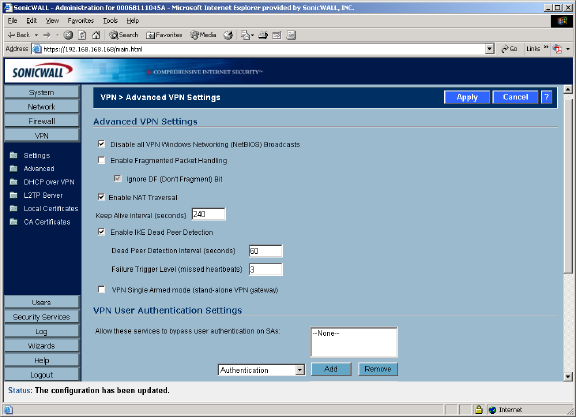
Page 46 SonicWALL SonicOS Standard Administrator’s Guide
13. Click OK. Your new VPN policy is displayed in the VPN Policies table.
VPN>Advanced
The VPN>Advanced page includes optional settings that affect all VPN policies.
Advanced VPN Settings
•Disable all VPN Windows Networking (NetBIOS) Broadcasts - Computers running Microsoft Win-
dows® communicate with one another through NetBIOS broadcast packets. Disable this setting ac-
cess remote network resources by browsing the Windows®
Network Neighborhood.
•Enable Fragmented Packet Handling - if the VPN log report shows the log message “Fragmented
IPSec packet dropped”, select this feature. Do not select it until the VPN tunnel is established and in
operation. When you select this setting, the Ignore DF (Don’t Fragment) Bit setting becomes active.
•Enable NAT Traversal - Select this setting is a NAT device is located between your VPN endpoints.
IPSec VPNs protect traffic exchanged between authenticated endpoints, but authenticated endpoints
cannot be dynamically re-mapped mid-session for NAT traversal to work. Therefore, to preserve a
dynamic NAT binding for the life of an IPSec session, a 1-byte UDP is designated as a “NAT Traversal
keepalive” and acts as a “heartbeat” sent by the VPN device behind the NAT or NAPT device. The
“keepalive” is silently discarded by the IPSec peer.
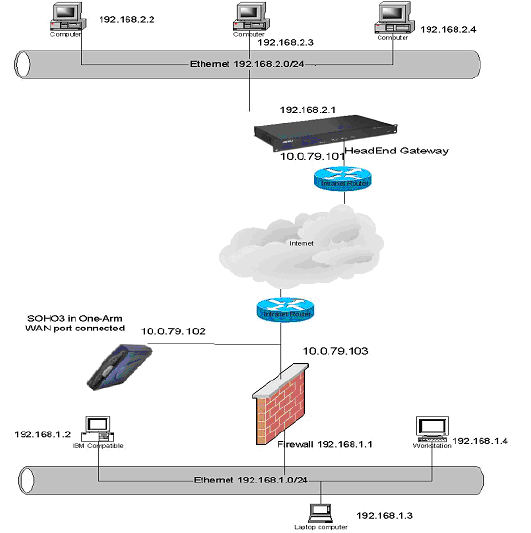
VPN Page 47
Selecting Enable NAT Traversal allows VPN tunnels to support this protocol, and log messages are
generated by the SonicWALL when a IPSec Security Gateway is detected behind a NAT/NAPT
device. The following log messages are found on the View Log tab:
Peer IPSec Gateway behind a NAT/NAPT device
Local IPSec Security Gateway behind a NAT/NAPT device
No NAT/NAPT device detected between IPSec Security
Peer IPSec Security Gateway doesn’t support VPN NAT Traversal
•Keep Alive interval (seconds) - the default value is 240 seconds (4 minutes). If Enable Keep Alive
is selected on the Advanced VPN Settings page, a new negotiation begins if the previous VPN Pol-
icy was deleted by Dead Peer Detection (DPD).
•Enable IKE Dead Peer Detection - select if you want inactive VPN tunnels to be dropped by the Son-
icWALL. Enter the number of seconds between “heartbeats” in the Dead Peer Detection Interval
(seconds) field. The default value is 60 seconds. Enter the number of missed heartbeats in the Fail-
ure Trigger Level (missed heartbeats) field. The default value is 3. If the trigger level is reached,
the VPN connection is dropped by the
SonicWALL. The SonicWALL uses a UDP packet protected by Phase 1 Encryption as the heartbeat.
VPN Single-Armed Mode (stand-alone VPN gateway)
VPN Single-Armed Mode allows you to deploy a SonicWALL with single port (WAN) utilized as a VPN
tunnel termination point. Clear text traffic is routed to the single interface and the data is encapsulated to
the appropriate IPSec gateway.
An example of a deployment is to place the SonicWALL between the existing firewall and the router
connected to the Internet. Traffic is sent in clear text to the SonicWALL, then encrypted and sent to the
appropriate VPN Gateway.

Page 48 SonicWALL SonicOS Standard Administrator’s Guide
If VPN Single-Armed Mode (stand-alone VPN gateway) is enabled, a warning message appears as
follows:
Click OK to enable the SonicWALL in VPN Single Armed Mode.
Configuring a SonicWALL for VPN Single Armed Mode
You have the following information to configure the IP addresses on the firewalls:
To configure a SonicWALL in VPN Single Armed Mode in front of an existing SonicWALL, follow these
steps:
1. Configure the Remote and Local SonicWALLs in your preferred networking mode.
2. Configure a VPN SA using IKE and Pre-shared Secret on the Remote SonicWALL using the VPN
WAN IP address as the IPSec Gateway, and the Local SonicWALL WAN IP address as the
Destination Network.
3. Configure a Static Route on the Local SonicWALL to send network traffic destined for the Remote
SonicWALL to the VPN SonicWALL.
4. Configure the VPN SonicWALL in Standard networking mode.
5. Click Advanced, then Intranet. Select the VPN Single Armed Mode (stand alone VPN gateway)
check box, and click Update.
6. A rule is automatically added to the VPN SonicWALL for HTTPS management from the WAN. The
LAN port is disabled when you configure a SonicWALL for VPN Single Armed mode.
7. Configure a VPN SA using IKE and Pre-shared Secret on the VPN SonicWALL to securely connect
to the Remote SonicWALL. Enter the Remote SonicWALL WAN IP address as the IPSec Gateway
and the Remote SonicWALL LAN IP Address range as the Destination Network, if configuring “Many
to One NAT”.
8. Click Advanced, and then Routes. Enter the Corporate SonicWALL WAN IP address in the Dest.
Network field. Enter the subnet mask in the Subnet Mask field. Enter the Local SonicWALL WAN IP
address as the Gateway, and select WAN from the Link menu. Click Update.
Remote SonicWALL Corporate SonicWALL
WAN IP Address: 66.120.118.11 WAN IP Address:66.120.118.25
Subnet Mask: 255.255.255.0 Subnet Mask: 255.255.255.0
LAN IP Address 192.168.1.1 LAN IP Address: 192.168.3.1
Subnet Mask: 255.255.255.0 Subnet Mask: 255.255.255.0
VPN Single Armed Mode SonicWALL
WAN IP Address: 66.120.118.13
Subnet Mask: 255.255.255.0
LAN IP Address: 192.168.2.1
Subnet Mask: 255.255.255.0

VPN Page 49
• Now that all SonicWALLs are configured, network traffic on the corporate SonicWALL destined for the
remote office is routed to the VPN SonicWALL, encrypted, and sent to the remote SonicWALL.
VPN User Authentication Settings
•Allow these services to bypass user authentication on SAs - this feature allows VPN users with-
out authentication to access the specified services. To add a service, select the service from the menu
and click Add. The service is added to the Allow these services to bypass user authentication on
SAs list. To remove a service, select the service in the Allow these services to bypass user au-
thentication on VPN SAs list and click Remove.
•Allow these address ranges to bypass user authentication on SAs - this feature allows the spec-
ified IP address or IP address range to bypass user authentication on VPN connections. To add an
IP address, enter the single IP address in the text box, then click Add. To add an IP address range,
enter the range starting IP address in the first field and the ending IP address in the text field (up to
the last three numbers of the IP address).
VPN Bandwidth Management
Bandwidth management is a means of allocating bandwidth resources to critical applications on a
network. The VPN Bandwidth Management section allows you to define the amount of outbound VPN
traffic allowed from the SonicWALL. Traffic is then scheduled in Kbps according to Guaranteed
Bandwidth (minimum) and Maximum Bandwidth settings.
To enable VPN Bandwidth Management, follow these steps:
1. Select Enable VPN Bandwidth Management.
2. Enter the minimum amount of bandwidth allowed in the Guaranteed Bandwidth (Kbps) field.
3. Enter the maximum amount of bandwidth allowed in Maximum Bandwidth (Kbps) field.
4. Select VPN bandwidth priority from the Priority menu, 0 (highest) to 7 (lowest).
5. Click Apply.
Tip!
Bandwidth management is available only on outbound VPN traffic. You cannot configure individual
Security Associations to use bandwidth management.
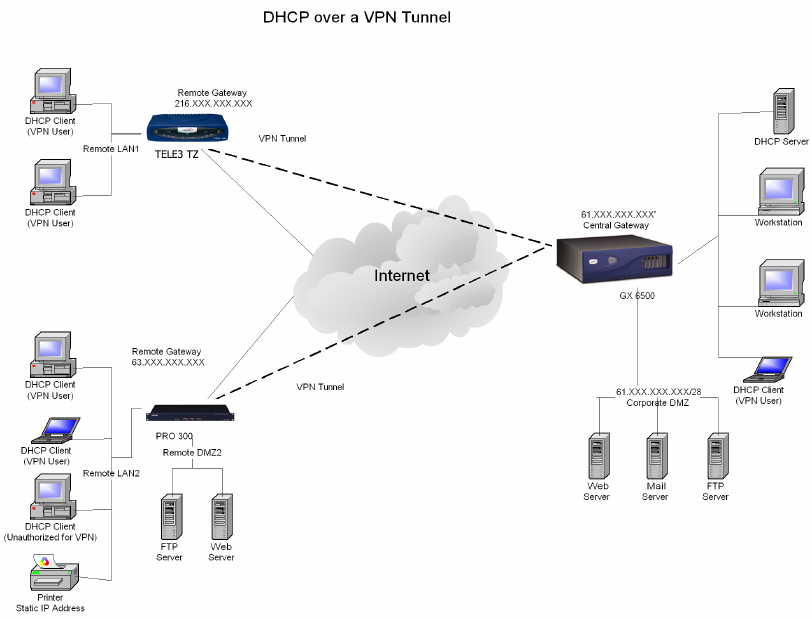
Page 50 SonicWALL SonicOS Standard Administrator’s Guide
VPN>DHCP over VPN
DHCP over VPN allows a Host (DHCP Client) behind a SonicWALL obtain an IP address lease from a
DHCP server at the other end of a VPN tunnel. In some network deployments, it is desirable to have all
VPN networks on one logical IP subnet, and create the appearance of all VPN networks residing in one
IP subnet address space. This facilitates IP address administration for the networks using VPN tunnels.
DHCP Relay Mode
The SonicWALL appliance at the remote and central site are configured for VPN tunnels for initial DHCP
traffic as well as subsequent IP traffic between the sites. The SonicWALL at the remote site (Remote
Gateway) passes DHCP broadcast packets through its VPN tunnel. The SonicWALL at the central site
(Central Gateway) relays DHCP packets from the client on the remote network to the DHCP server on
the central site.
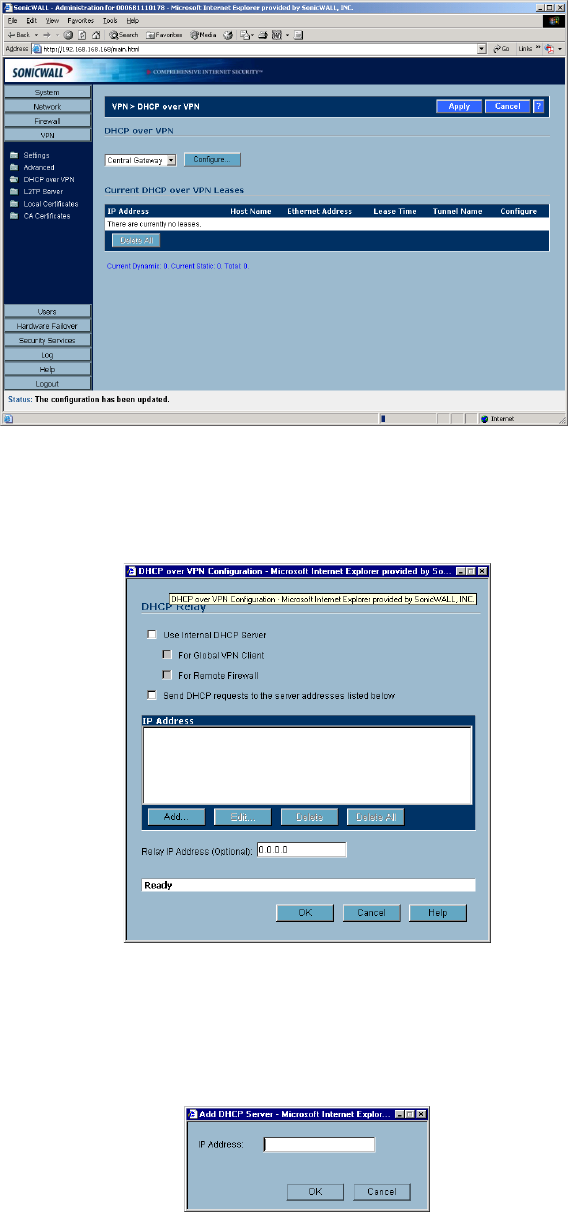
VPN Page 51
Configuring the Central Gateway for DHCP Over VPN
To configure DHCP over VPN for the Central Gateway, use the following steps:
1. Log into the Management interface, click DHCP, and then DHCP over VPN.
2. Select Central Gateway from the DHCP Relay Mode menu.
3. Click Configure. The DHCP over VPN Configuration window is displayed.
4. Select Use Internal DHCP Server to enable the Global VPN Client or a remote firewall or both to use
an internal DHCP server to obtain IP addressing information.
5. If you want to send DHCP requests to specific servers, select Send DHCP requests to the server
addresses listed below.
6. Click Add. The IP Address window is displayed.
7. Enter the IP addresses of DHCP servers in the IP Address field, and click OK. The SonicWALL now
directs DHCP requests to the specified servers.
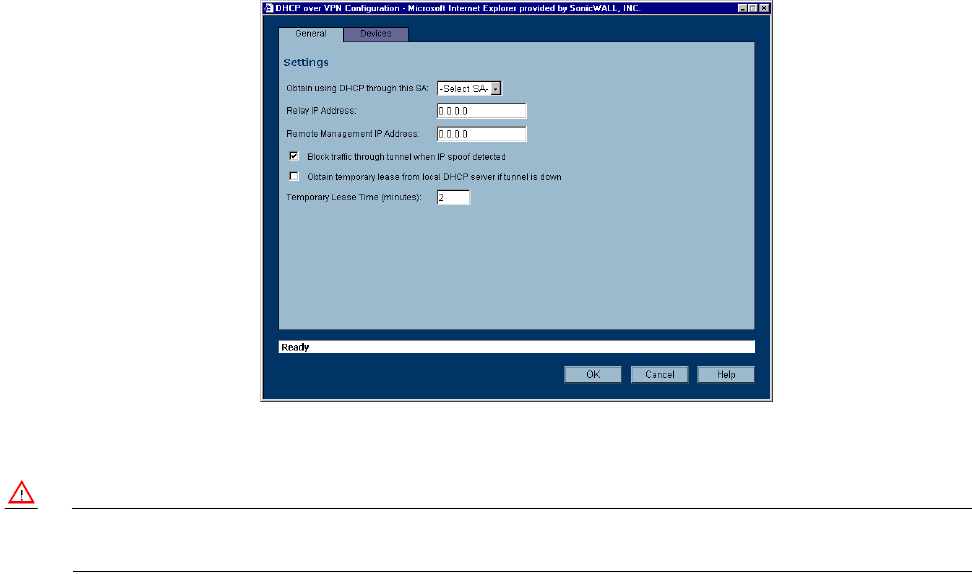
Page 52 SonicWALL SonicOS Standard Administrator’s Guide
8. Enter the IP address of a relay server in the Relay IP Address (Optional) field.
To edit an entry in the IP Address table, click Edit. To delete a DHCP Server, highlight the entry in the
IP Address table, and click Delete. Click Delete All to delete all entries.
Configuring DHCP over VPN Remote Gateway
1. Select Remote Gateway from the DHCP Relay Mode menu.
2. Click Configure. The DHCP over VPN Configuration window is displayed.
3. Select the VPN Security Association to be used for the VPN tunnel from the Relay DHCP through
this VPN Tunnel menu.
Alert!
Only VPN Security Associations using IKE and terminate on the LAN appear in the Obtain using DHCP
through this VPN Tunnel.
4. The Relay IP address is used in place of the Central Gateway address, and must be reserved in the
DHCP scope on the DHCP server. The Relay IP address can also be used to manage the SonicWALL
remotely through the VPN tunnel behind the Central Gateway.
5. The Remote Management IP Address, if entered, can be used to manage the SonicWALL remotely
through the VPN tunnel behind the Central Gateway.
6. If you enable Block traffic through tunnel when IP spoof detected, the SonicWALL blocks any
traffic across the VPN tunnel that is spoofing an authenticated user’s IP address. If you have any static
devices, however, you must ensure that the correct Ethernet address is entered for the device. The
Ethernet address is used as part of the identification process, and an incorrect Ethernet address can
cause the SonicWALL to respond to IP spoofs.
7. If the VPN tunnel is disrupted, temporary DHCP leases can be obtained from the local DHCP server.
Once the tunnel is again active, the local DHCP server stops issuing leases. Enable the Obtain
temporary lease from local DHCP server if tunnel is down check box. By enabling this check box,
you have a failover option in case the tunnel ceases to function. If you want to allow temporary leases
for a certain time period, enter the number of minutes for the temporary lease in the Temporary
Lease Time box. The default value is two (2) minutes.
Device Configuration
8. To configure Static Devices on the LAN, click Add, and enter the IP address of the device in the IP
Address field and then enter the Ethernet Address of the device in the Ethernet Address field. An

VPN Page 53
example of a static device is a printer as it cannot obtain an IP lease dynamically. If you do not have
Block traffic through tunnel when IP spoof detected enabled, it is not necessary to enter the
Ethernet address of a device.
9. You must exclude the Static IP addresses from the pool of available IP addresses on the DHCP server
so that the DHCP server does not assign these addresses to DHCP clients. You should also exclude
the IP address used as the Relay IP Address. It is recommended to reserve a block of IP address to
use as Relay IP addresses. Click Add, and enter the Ethernet address in the Ethernet Address field.
Alert!
You must configure the local DHCP server on the remote SonicWALL to assign IP leases to these
computers.
Alert!
If a remote site has trouble connecting to a central gateway and obtaining a lease, verify that
Deterministic Network Enhancer (DNE) is not enabled on the remote computer.
Tip!
If a static LAN IP address is outside of the DHCP scope, routing is possible to this IP, i.e. two LANs.
Current DHCP over VPN Leases
The scrolling window shows the details on the current bindings: IP and Ethernet address of the bindings,
along with the Lease Time, and Tunnel Name. To edit an entry, click the Notepad icon under Configure
for that entry.
To delete a binding, which frees the IP address in the DHCP server, select the binding from the list, and
then click the Trashcon icon. The operation takes a few seconds to complete. Once completed, a
message confirming the update is displayed at the bottom of the Web browser window.
Click Delete All to delete all VPN leases.
VPN>L2TP Server
You can use Layer 2 Tunneling Protocol (L2TP) to create VPN over public networks such as the Internet.
L2TP provides interoperability between different VPN vendors that protocols such as PPTP and L2F do
not, although L2TP combines the best of both protocols and is an extension of them. L2TP is supported
on Microsoft Windows 2000 Operating System.
L2TP supports several of the authentication options supported by PPP, including Password
Authentication Protocol (PAP), Challenge Handshake Authentication Protocol (CHAP), and Microsoft
Challenge Handshake Authentication Protocol (MS-CHAP). You can use L2TP to authenticate the
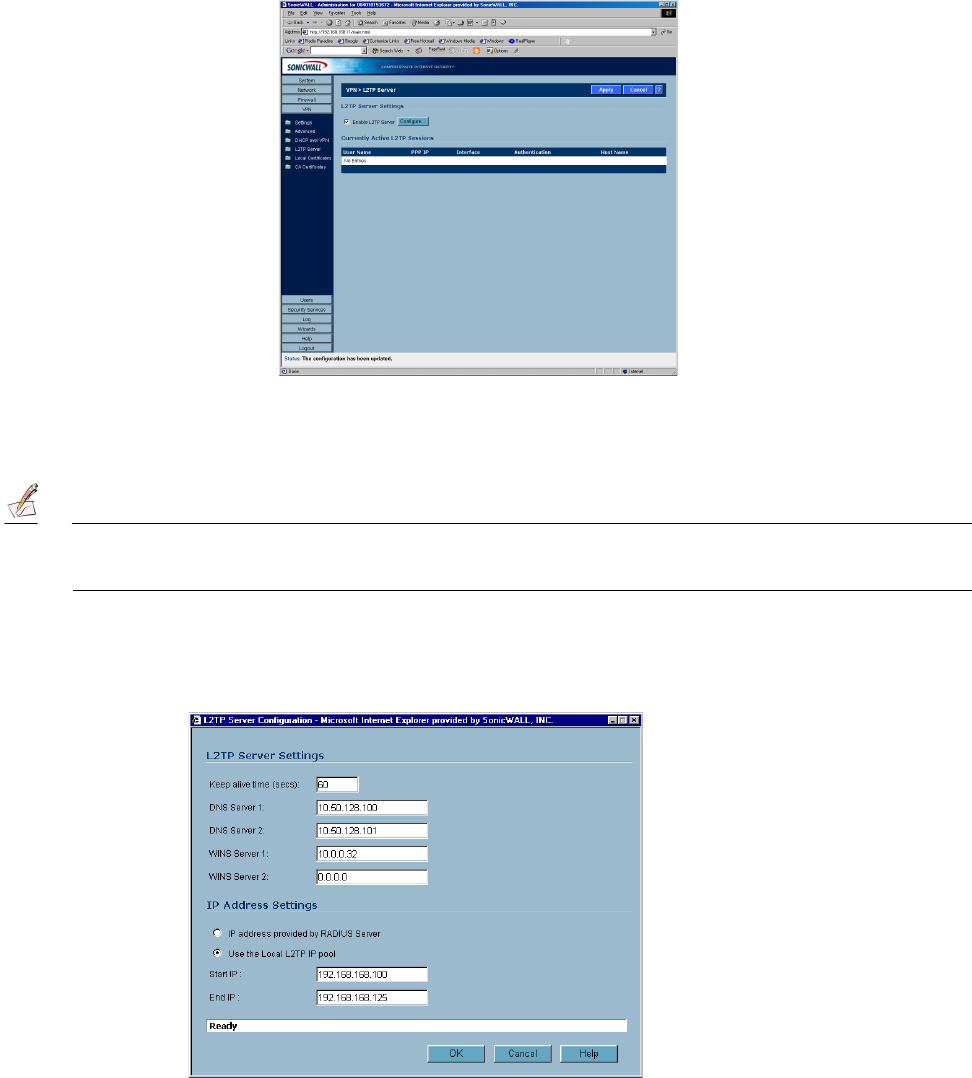
Page 54 SonicWALL SonicOS Standard Administrator’s Guide
endpoints of a VPN tunnel to provide additional security, and you can implement it with IPSec to provide
a secure, encrypted VPN solution.
General
Note:
You must enable Group VPN before configuring the SonicWALL L2TP feature. Also, the encryption
method and shared secret must match the L2TP client settings.
To enable L2TP Server functionality on the SonicWALL, select Enable L2TP Server. Then click
Configure to display the L2TP Server Configuration window.
L2TP Server Settings
Configure the following settings:
1. Enter the number of seconds in the Keep alive time (secs) field to send special packets to keep the
connection open.
2. Enter the IP address of your first DNS server in the DNS Server 1 field.
3. If you have a second DNS server, enter the IP address in the DNS Server 2 field.
VPN Page 55
4. Enter the IP address of your first WINS server in the WINS Server 1 field.
5. If you have a second WINS server, enter the IP address in the WINS Server 2 field.
IP Address Settings
6. Select IP address provided by RADIUS Server if a RADIUS Server provides IP addressing
information to the L2TP clients.
7. If the L2TP Server provides IP addresses, select Use the Local L2TP IP pool. Enter the range of
private IP addresses in the Start IP and End IP fields. The private IP addresses should be a range of
IP addresses on the LAN.
8. Click OK.
Adding L2TP Clients to the SonicWALL
To add L2TP clients to the local user database or a RADIUS database, click Users, then Add. When
adding privileges for a user, select L2TP Client as one of the privileges. Then the user can access the
SonicWALL as a L2TP client.
Currently Active L2TP Sessions
•User Name - the user name assigned in the local user database or the RADIUS user database.
•PPP IP - the source IP address of the connection.
•Interface - the enter of interface used to access the L2TP Server, whether it’s a VPN client or another
SonicWALL appliance.
•Authentication - enter of authentication used by the L2TP client.
•Host Name - the name of the network connecting to the L2TP Server.
Digital Certificates
Overview of X.509 v3 Certificates
A digital certificate is an electronic means to verify identity by a trusted third party known as a Certificate
Authority (CA). X.509 v3 certificate standard is a specification to be used with cryptographic certificates
and allows you to define extensions which you can include with your certificate. SonicWALL has
implemented this standard in its third party certificate support.
You can use a certificate signed and verified by a third party CA to use with an IKE (Internet Key Exchange
VPN policy. IKE is an important part of IPSec VPN solutions, and it can use digital certificates to
authenticate peer devices before setting up SAs. Without digital certificates, VPN users must authenticate
by manually exchanging shared secrets or symmetric keys. Devices or clients using digital signatures do
not require configuration changes every time a new device or client is added to the network.
A typical certificate consists of two sections: a data section and a signature section. The data section
typically contains information such as the version of X.509 supported by the certificate, a certificate serial
number, information, information about the user’s public key, the Distinguished Name (DN), validation
period for the certificate, optional information such as the target use of the certificate. The signature
section includes the cryptographic algorithm used by the issuing CA, and the CA digital signature.
SonicWALL Third Party Digital Certificate Support
SonicWALL supports third party certificates from the following two vendors of Certificate Authority
Certificates:
• VeriSign
•Entrust
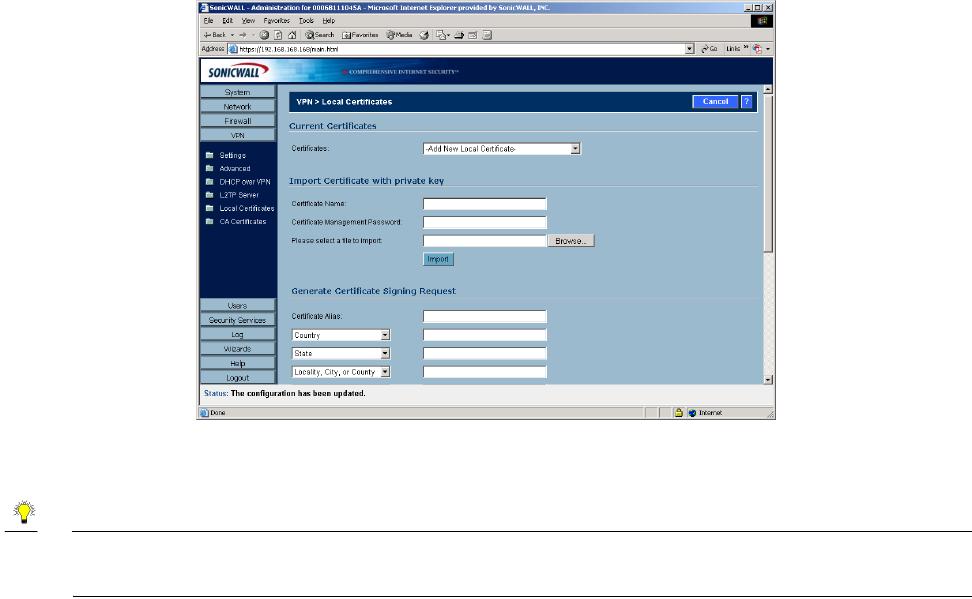
Page 56 SonicWALL SonicOS Standard Administrator’s Guide
To implement the use of certificates for VPN SAs, you must locate a source for a valid CA certificate from
a third party CA service. Once you have a valid CA certificate, you can import it into the SonicWALL to
validate your Local Certificates. You import the valid CA certificate into the SonicWALL using the
VPN>CA Certificates page. Once you import the valid CA certificate, you can use it to validate your local
certificates you add in the VPN>Local Certificates page.
VPN>Local Certificates
After a certificate is signed by the CA and returned to you, you can import the certificate into the
SonicWALL to be used as a Local Certificate for a VPN Security Association.
Tip!
After you import a local certificate on the SonicWALL, it is recommended you export the certificate to
the local disk as a backup. When exporting a local certificate, a password is required.
Importing Certificate with Private Key
Use the following steps to import the certificate into the SonicWALL:
1. In the Import Certificate with private key section of Local Certificates, type the Certificate Name.
2. Type the Certificate Management Password. This password was created when you exported your
signed certificate.
3. Use Browse to locate the certificate file.
4. Click Import, and the certificate appears in the list of Current Certificates.
5. To view details about the certificate, select it from the list of Current Certificates.
Certificate Details
To view details about the certificate, select the certificate from the Certificates menu in the Current
Certificates section. The Certificate Details section lists the following information about the certificate:
• Certificate Issuer
• Subject Distinguished Name
• Certificate Serial Number

VPN Page 57
• Expiration On
• Alternate Subject Name
• Alternate Subject Name Type
•Status
Delete This Certificate
To delete the certificate, click Delete This Certificate. You can delete a certificate if it has expired or if
you decide not to use third party certificates for VPN authentication.
Generating a Certificate Signing Request
To generate a local certificate for use with a VPN policy, follow these steps:
Tip!
You should create a Certificate Policy to be used in conjunction with local certificates. A Certificate
Policy determines the authentication requirements and the authority limits required for the validation of
a certificate.
1. Select Add New Local Certificate from the Certificates menu.
2. In the Generate Certificate Signing Request section, enter a name for the certificate in the
Certificate Name field.
3. Enter information for the certificate in the Request fields. As you enter information in the Request
fields, the Distinguished Name (DN) is created in the Subject Distinguished Name field.
You can also attach an optional Subject Alternative Name to the certificate such as the Domain
Name or E-mail Address. You need to provide the proper input for the Domain Name
(yourcompanyname.com) or E-mail Address (abc@yourcompanyname.com) option in the
corresponding field.
4. The Subject Key type is preset as an RSA algorithm. RSA is a public key cryptographic algorithm
used for encrypting data.
5. Select a Subject Key size from the Subject Key Size menu.
Note:
Not all key sizes are supported by a Certificate Authority, therefore you should check with your CA for
support key sizes.
6. Click Generate to create a certificate file. Once the Certificate Signing Request is generated, a
message describing the result is displayed.
7. Click Export to download the file to your computer, then click Save to save it to a directory on your
computer.
You have generated the Certificate Request that you can send to your Certificate Authority for validation.
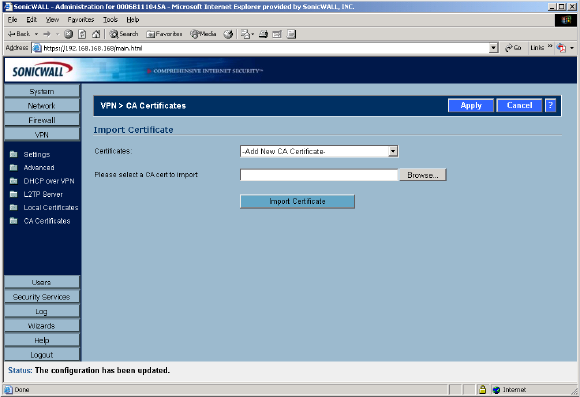
Page 58 SonicWALL SonicOS Standard Administrator’s Guide
VPN>CA Certificates
Importing CA Certificates into the SonicWALL
After your CA service has validated your CA Certificate, you can import it into the SonicWALL and use it
to validate Local Certificates for VPN Security Associations.
To import your CA Certificate into the SonicWALL, follow these steps:
1. Select Add New CA Certificate.
2. Click Browse, and locate the PKCS#7 (*.p7b) or DER (*.der) or *.cer encoded file sent by the CA
service.
3. Click Open to set the directory path to the certificate
4. Click Import to import the certificate into the SonicWALL. Once it is imported, you can view the
Certificate Details.
Certificate Details
The Certificate Details section lists the following information:
• Certificate Issuer
• Subject Distinguished Name
• Certificate Serial Number
• Expires On
• CRL Status
The Certificate Issuer, Certificate Serial Number, and the Expiration Date are generated by the CA
service. The information is used when a Generate Certificate Signing Request is created and sent to
your CA service for validation.
Delete This Certificate
To delete the certificate, click Delete This Certificate. You can delete a certificate if it has expired or if
you decide not to use third party certificates for VPN authentication.

VPN Page 59
Certificate Revocation List (CRL)
A Certificate Revocation List (CRL) is a way to check the validity of an existing certificate. A certificate
may be invalid for several reasons:
• It is no longer needed.
• A certificate was stolen or compromised.
• A new certificate was issued that takes precedence over the old certificate.
If a certificate is invalid, the CA may publish the certificate on a Certificate Revocation List at a given
interval, or on an online server in a X.509 v3 database using Online Certificate Status Protocol (OCSP).
Consult your CA provider for specific details on locating a CRL file or URL.
Tip!
The SonicWALL supports obtaining the CRL via HTTP or manually downloading the list.
You can import the CRL by manually downloading the CRL and then importing it into the SonicWALL. You
can also enter the URL location of the CRL by entering the address in the Enter CRL’s location (URL)
for auto-import field. The CRL is downloaded automatically at intervals determined by the CA service.
Certificates are checked against the CRL by the SonicWALL for validity when they are used.
Importing a CRL List
To import a CRL list, follow these steps:
1. Click Browse for Please select a file to import.
2. Locate the PKCS#12 (*.p12) or Micorosft (*.pfx) encoded file.
3. Click Open to set the directory path to the certificate.
4. Click Import to import the certificate into the SonicWALL.
Automatic CRL Update
To enable automatic CRL updates to the SonicWALL, type the URL of the CRL server for your CA service
in the Enter CRL’s location (URL) for auto-import, then click Apply.
Page 60 SonicWALL SonicOS Standard Administrator’s Guide
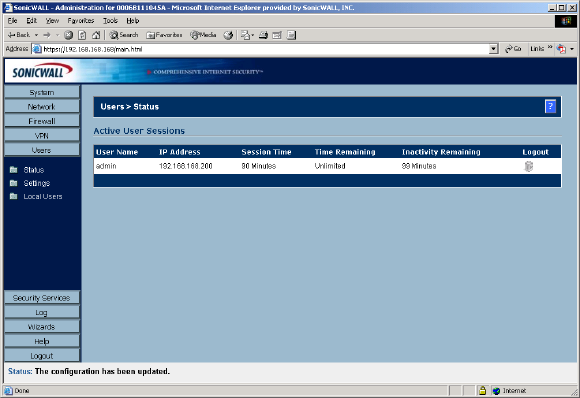
Users Page 61
10 Users
The SonicWALL provides a mechanism for user level authentication that gives users access to the LAN
from remote locations on the Internet as well as a means to bypass content filtering. Also, you can permit
only authenticated users to access VPN tunnels and send data across the encrypted connection.
User level authentication can performed using a local user database, RADIUS, or a combination of the
two applications. The local database on the SonicWALL can support up to 1,000 users. If you have more
than 1,000 users or want to add an extra layer of security for authenticating users to the SonicWALl, use
RADIUS for authentication.
Users>Status
Active User Sessions
The Active User Sessions table lists the User Name, the IP Address of the user, the Session Time, Time
Remaining of the session, and the Inactivity Remaining time. You can also click the Trashcan icon in
the Logout column to log a user out of the SonicWALL.
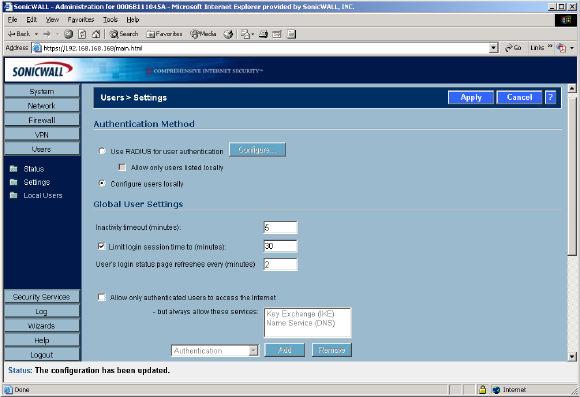
Page 62 SonicWALL SonicOS Standard Administrator’s Guide
Users>Settings
On this page, you can configure the authentication method required, global user settings, and an
acceptable user policy that is displayed to users when logging onto your network. The SonicWALL
supports user level authentication using the local SonicWALL database, a RADIUS server, or a
combination of the two authentication methods.
Authentication Method
•Use RADIUS for user authentication - if you have more than 1,000 users or want to add an extra
layer of security for authenticating the user to the SonicWALL. If you select Use RADIUS for user au-
thentication, users must log into the SonicWALL using HTTPS in order to encrypt the password sent
to the SonicWALL. If a user attempts to log into the SonicWALL using HTTP, the browser is automat-
ically redirected to HTTPS. If you select Use RADIUS for user authentication, the Configure button
becomes available.
•Allow only users listed locally - enable this setting if you have a subset of RADIUS users accessing
the SonicWALL. The user names must be added to the internal SonicWALL user database on the Us-
ers>Local Users page before they can be authenticated using RADIUS.
•Configure users locally - selecting this setting allows you to configure users in the local SonicWALL
database using the Users>Local Users page.
Global User Settings
The settings listed below apply to all users when authenticated through the SonicWALL.
•Inactivity timeout (minutes) - users can be logged out of the SonicWALL after a
preconfigured inactivity time. Enter the number of minutes in this field.
•Limit login session time to (minutes) - you can limit the time a user is logged into the SonicWALL
by selecting the check box and typing the amount of time, in minutes, in the Limit login session
time to (minutes) field. The default value is 30 minutes.
•Allow only authenticated users to access the Internet - this feature allows Internet access to only
users configured on the SonicWALL. There is a corresponding checkbox when adding a user to the
local SonicWALL database allowing you to grant
access to the Internet. When you select Allow only authenticated users to access the
Internet, but always allow these services, the default Key Exchange (IKE) and Name Service
(DNS) services are activated. You can add or remove services available to users. To add a service,
select the service from the menu, and click Add. To remove a service, select the service in the in the
services list, and click Remove.
•And always allow these address ranges - this feature allows the specified IP address or IP address
range to bypass user authentication. To add an IP address, enter the single IP address in the first
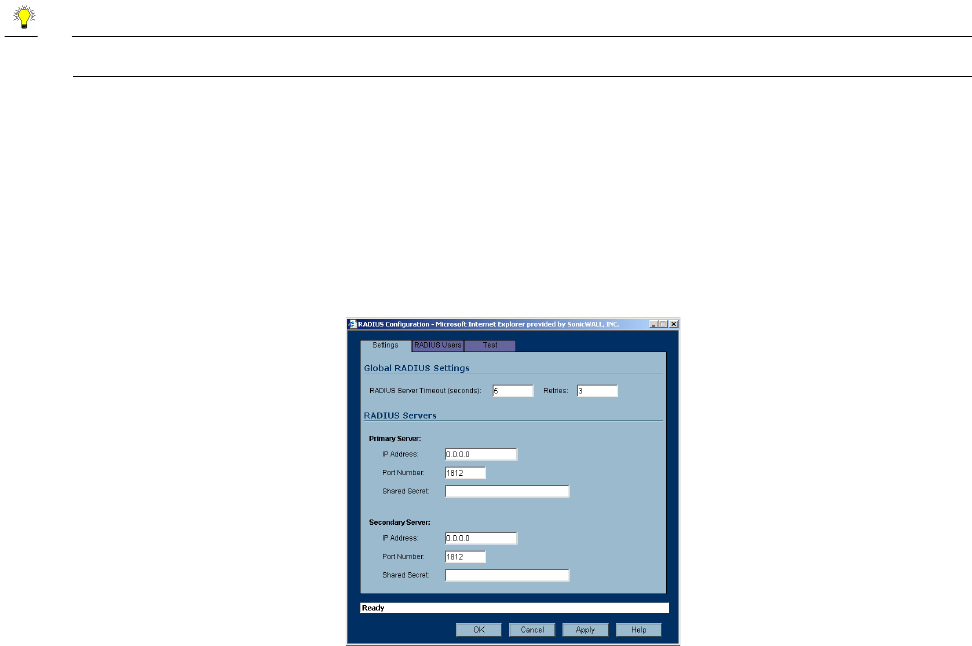
Users Page 63
field, then click Add. To add an IP address range, enter the range starting IP address in the first field
and the ending IP address in the next field (up to the last three numbers of the IP address.
Acceptable Use Policy
An acceptable use policy (AUP) is a policy users must agree to follow in order to access a network or the
Internet. It is common practice for many businesses and educational facilities to require that employees
or students agree to an acceptable use policy before accessing the network or Internet through the
SonicWALL.
LAN and DMZ are selected automatically from the Display on login from section. WAN and VPN are
also available.
In the Acceptable Use Policy field, enter the text of your policy. Click Apply to update the configuration.
Tip!
Acceptable Use Policies can use HTML formatting in the body of the message.
Configuring RADIUS Authentication
To enable the SonicWALL to use authentication from a RADIUS server, follow these steps:
1. Select Use RADIUS for user authentication.
2. Select Allow only users listed locally if only the users listed in the SonicWALL database are
authenticated using RADIUS.
3. Click Configure to set up your RADIUS server settings on the SonicWALL. The RADIUS
Configuration window is displayed.
4. In the Global RADIUS Settings section, define the RADIUS Server Timeout (seconds). The
allowable range is 1-60 seconds with a default value of 5.
5. Define the number of times the SonicWALL attempts to contact the RADIUS server in the Retries
field. If the RADIUS server does not respond within the specified number of retries, the connection is
dropped. This field can range between 1 and 10, however 3 RADIUS server retries is recommended.
6. In the RADIUS Servers section, specify the settings of the primary RADIUS server in the RADIUS
servers section. An optional secondary RADIUS server can be defined if a backup RADIUS server
exists on the network.
7. Type the IP address of the RADIUS server in the IP Address field.
8. Type the Port Number for the RADIUS server.
9. Type the RADIUS server administrative password or “shared secret” in the Shared Secret field. The
alphanumeric Shared Secret can range from 1 to 31 characters in length. The shared secret is case
sensitive.

Page 64 SonicWALL SonicOS Standard Administrator’s Guide
10. If there is a secondary RADIUS server, type the appropriate information in the Secondary Server
section.
11. Click the RADIUS Users tab.
12. Select the default privileges for all RADIUS users in this section.
Access to the Internet (when access is restricted) - If you have selected Allow only
authenticated users to access the Internet, you can allow individual users to access the Internet.
Bypass Filters - Enable this feature if the user has unlimited access to the Internet from the LAN,
bypassing SonicWALL Web, News, Java, and ActiveX blocking.
Access to VPNs - Enable feature to allow the user to send information over the VPN connection with
authentication enforcement.
Access from the VPN Client with XAUTH - Enable this feature if the user requires XAUTH for
authentication and accesses the SonicWALL via a VPN client.
Access from L2TP VPN client - Enable this feature to allow the user to send information using a
L2TP VPN Client with authentication enforcement.
Limited Management Capabilities - Enabling this feature allows the user to have limited local
management access to the SonicWALL Management Interface. This access is limited to the following
pages: General (Status, Network, Time); Log (View Log, Log Settings, Log Reports); Diagnostics
(All tools except Tech Support Report).
13. Click Apply, then click the Test tab.
14. Type in a valid user name in the User field, and the password in the Password field.
15. Click Test. If the validation is successful, the Status messages changes to Success. If the validation
fails, the Status message changes to Failure.
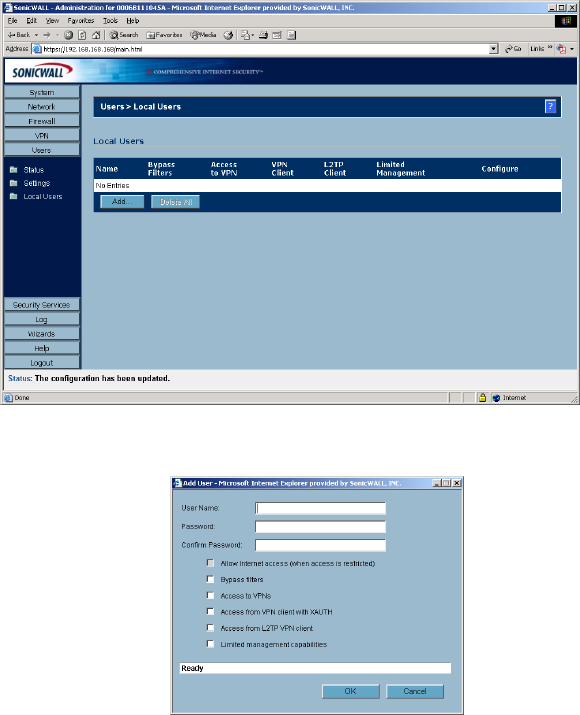
Users Page 65
16. Click OK.
Once the SonicWALL has been configured, a VPN Security Association requiring RADIUS authentication
prompts incoming VPN clients to type a User Name and Password into a dialogue box.
Users>Local Users
Add local users to the SonicWALL internal database. Click Add User to display the Add User
configuration window. Follow the steps below to add users locally.
Settings
1. Create a user name and type it in the User Name field.
2. Create a password for the user and type it in the Password field. Passwords are case-sensitive and
should consist of a combination of letters and numbers rather than names of family, friends, or pets.
3. Confirm the password by retyping it in the Confirm Password field.
4. Select from the following list of privileges to assign the user:
Access to the Internet (when access is restricted) - If you have selected Allow only
authenticated users to access the Internet, you can allow individual users to access the Internet.
Bypass Filters - Enable this feature if the user has unlimited access to the Internet from the LAN,
bypassing SonicWALL Web, News, Java, and ActiveX blocking.
Access to VPNs - Enable feature to allow the user to send information over the VPN connection with
authentication enforcement.
Access from the VPN Client with XAUTH - Enable this feature if the user requires XAUTH for
authentication and accesses the SonicWALL via a VPN client.
Page 66 SonicWALL SonicOS Standard Administrator’s Guide
Access from L2TP VPN client - Enable this feature to allow the user to send information using a
L2TP VPN Client with authentication enforcement.
Limited Management Capabilities - Enabling this feature allows the user to have limited local
management access to the SonicWALL Management Interface. This access is limited to the following
pages: General (Status, Network, Time); Log (View Log, Log Settings, Log Reports); Diagnostics
(All tools except Tech Support Report).
5. Click OK.
The users you add appear in the Local Users table with their privileges listed. Click the Notepad icon in
the Configure column to edit the user information. Click the Trashcan to delete a user.

Security Services Page 67
11 Security Services
Security Services allows you to manage SonicWALL Security Services and Upgrades for your
SonicWALL. SonicWALL, Inc. offers a variety of subscription-based Security Services and Upgrades to
enhance the functionality of your SonicWALL. You can activate and manage Security Services directly
from the SonicWALL Management Interface or from
https://www.mySonicWALL.com. SonicWALL Security Services and Upgrades are designed to integrate
seamlessly into your network to provide complete protection.
Note:
For more information on SonicWALL Security Services and Upgrades, please visit
<http://www.sonicwall.com.
This chapter provides an overview of the SonicWALL Security Services listed under Security Services in
the SonicWALL Management Interface, which includes:
• SonicWALL Content Filtering Service
• SonicWALL Network Anti-Virus
• SonicWALL E-Mail Filter
• SonicWALL Intrusion Prevention Service
Tip!
You can try FREE TRIAL of these services directly from the SonicWALL Management Interface.
This chapter also explains how to configure the SonicWALL Restrict Web Features and Trusted Domains
features on the Security Services>Content Filtering page that are included with SonicOS.
Note:
For complete product documentation for the SonicWALL Security Services in this chapter as well as all
SonicWALL Security Services and Upgrades, visit the SonicWALL documentation site at
www.sonicwall.com/services/documentation.
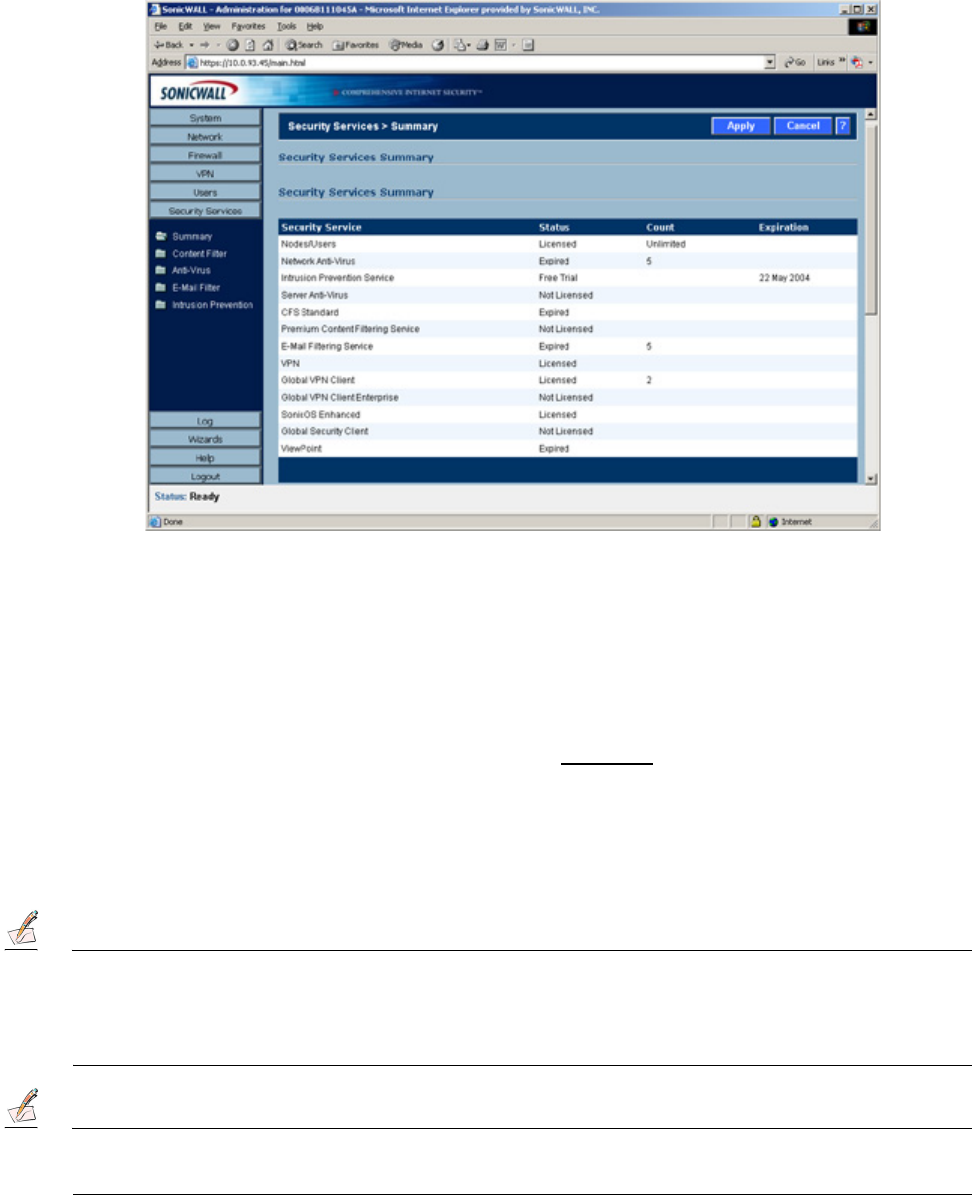
Page 68 SonicWALL SonicOS Standard Administrator’s Guide
Security Services>Summary
The Security Services>Summary page lists the available SonicWALL security services and upgrades
available for your SonicWALL and provides access to mySonicWALL.com to activate services.
Security Services Summary
A list of currently available services through mySonicWALL.com is displayed in the Security Services
Summary table. Subscribed services are displayed with Licensed in the Status column. If the service is
limited to a number of users, the number is displayed in the Count column. The service expiration date is
displayed in the Expiration column.
Manage Services Online
Clicking the To Activate, Upgrade, or Renew services, click here. link displays the
mySonicWALL.com Login page.
Enter your mySonicWALl.com username and password in the User Name and Password fields, and then
click Submit. The System>Licenses page is displayed with the Manage Services Online table. The
information in the Manage Services Online table is updated from your mysSonicWALL.com account.
Note:
If you have activated SonicWALL Global Security Client on your SonicWALL, a Policy Editor button is
displayed below the Manage Services Online table for configuring security policies. See the
SonicWALL Global Security Client Administrator’s Guide for instructions on configuring the Policy
Editor.
Note:
For more information on activating, upgrading, or renewing a SonicWALL Security Service or Upgrade,
see System>Licenses in Chapter 3.

Security Services Page 69
If Your SonicWALL is Not Registered
If your SonicWALL is not registered, the Security Services>Summary page does not include the
Services Summary table.
Your SonicWALL must be registered to display the Services Summary table. You can register your
SonicWALL via the Management Interface on the System>Status page. You must have a
mySonicWALL.com account to register your SonicWALL via the Management Interface. You can create
a mySonicWALL.com account from the Security Services>Summary page using the To Activate,
Upgrade, or Renew services, click here. link, which displays the mySonicWALL.com Login page.
Click the here link on the mySonicWALL.com Login page to display the mySonicWALL account
registration form. Complete the form, and click Submit.
Note:
For more information on mySonicWALL.com, visit the mySonicWALL.com site at
<https://www.mysonicwall.com> and click the question (?) icon.
Security Services Settings
•Reduce Anti-Virus and E-mail Filter traffic for ISDN connections - Selecting this feature enables
the SonicWALL Anti-Virus to only check daily (every 24 hours) for updates and reduces the frequency
of outbound traffic for users who do not have an “always on” Internet connection.
•Synchronize - Click Synchronize to update the licensing and subscription information on the
SonicWALL.
SonicWALL Content Filtering Service
SonicWALL Content Filtering Service (CFS) enforces protection and productivity policies for businesses,
schools and libraries to reduce legal and privacy risks while minimizing administration overhead.
SonicWALL CFS utilizes a dynamic database of millions of URLs, IP addresses and domains to block
objectionable, inappropriate or unproductive Web content. At the core of SonicWALL CFS is an innovative
rating architecture that cross references all Web sites against the database at worldwide SonicWALL co-
location facilities. A rating is returned to the SonicWALL and then compared to the content filtering policy
established by the administrator. Almost instantaneously, the Web site request is either allowed through
or a Web page is generated by the SonicWALL informing the user that the site has been blocked
according to policy.
With SonicWALL CFS, network administrators have a flexible tool to provide comprehensive filtering
based on keywords, time of day, trusted and forbidden domain designations, and file types such as
Cookies, Java™ and ActiveX® for privacy. SonicWALL CFS automatically updates the filters, making
maintenance substantially simpler and less time consuming.
SonicWALL CFS can also be customized to add or remove specific URLs from the blocked list and to
block specific keywords. When a user attempts to access a site that is blocked by the SonicWALL, a
customized message is displayed on the user’s screen. SonicWALL Internet Security Appliances can also
be configured to log attempts to access sites on the SonicWALL Content Filtering Service database, on
a custom URL list, and on a keyword list to monitor Internet usage before putting new usage restrictions
in place.
•SonicWALL CFS Standard blocks 12 categories of objectionable, inappropriate or unproductive
Web content. SonicWALL CFS Standard runs on SonicOS Standard 2.0 (or higher).
•SonicWALL CFS Premium blocks 56 categories of objectionable, inappropriate or
unproductive Web content. SonicWALL CFS Premium provides network administrators with greater
control by automatically and transparently enforces acceptable use policies. SonicWALL CFS Premi-
um Productivity Edition and the SonicWALL CFS Premium
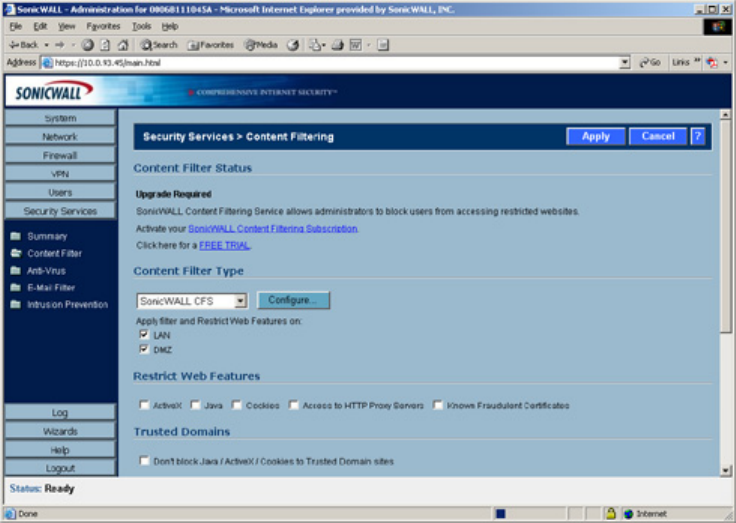
Page 70 SonicWALL SonicOS Standard Administrator’s Guide
Government/Education Edition run on SonicOS Standard 2.1 (or higher) as well as
SonicOS Enhanced 2.0 (or higher).
Security Services>Content Filter
The Security Services>Content Filter page allows you to configure the SonicWALL Restrict Web
Features and Trusted Domains settings, which are included with SonicOS. You can activate and
configure SonicWALL Content Filtering Service as well as two third-party Content Filtering products from
the Security Services>Content Filter page.
Content Filter Status
If SonicWALL CFS is activated, the Content Filter Status section displays the status of the Content Filter
Server, as well as the date and time that your subscription expires. The expiration date and time is
displayed in Universal Time Code (UTC) format.
You can also access the SonicWALL CFS URL Rating Review Request form by clicking on the here
link in If you believe that a Web site is rated incorrectly or you wish to submit a new URL, click here.
If SonicWALL CFS is not activated, you must activate it. If you do not have an Activation Key, you must
purchase SonicWALL CFS from a SonicWALL reseller or from your mySonicWALL.com account (limited
to customer in the USA and Canada).

Security Services Page 71
Activating SonicWALL CFS
If you have an Activation Key for your SonicWALL CFS subscription, follow these steps to activate
SonicWALL CFS:
Alert!
You must have a mySonicWALL.com account and your SonicWALL must be registered to activate
SonicWALL Network Anti-Virus.
1. Click the SonicWALL Content Filtering Subscription link on the Security Services>Content
Filtering page. The mySonicWALL.com Login page is displayed.
2. Enter your mySonicWALL.com account username and password in the User Name and Password
fields, then click Submit. The System>Licenses page is displayed. If your SonicWALL is already
connected to your mySonicWALL.com account, the System>Licenses page appears after you click
the SonicWALL Content Filtering Subscription link.
3. Click Activate or Renew in the Manage Service column in the Manage Services Online table. Type
in the Activation Key in the New License Key field and click Submit. Your SonicWALL CFS
subscription is activated on your SonicWALL.
If you activated SonicWALL CFS at mySonicWALL.com, the SonicWALL CFS activation is automatically
enabled on your SonicWALL within 24-hours or you can click the Synchronize button on the Security
Services>Summary page to update your SonicWALL.
Activating a SonicWALL CFS FREE TRIAL
You can try a FREE TRIAL of SonicWALL CFS by following these steps:
1. Click the FREE TRIAL link. The mySonicWALL.com Login page is displayed.
2. Enter your mySonicWALL.com account username and password in the User Name and Password
fields, then click Submit. The System>Licenses page is displayed. If your SonicWALL is already
connected to your mySonicWALL.com account, the System>Licenses page appears after you click
the FREE TRIAL link.
3. Click FREE TRIAL in the Manage Service column in the Manage Services Online table. Your
SonicWALL CFS trial subscription is activated on your SonicWALL.
Content Filter Type
There are three types of content filtering available on the SonicWALL.
•SonicWALL CFS - Selecting SonicWALL CFS as the Content Filter Type allows you to use the
SonicWALL Content Filtering Service that is available as an upgrade. You can obtain more informa-
tion about SonicWALL Content Filtering Service at <http://www.sonicwall.com/products/cfs.html
•N2H2 - N2H2 is a third party content filter software package supported by SonicWALL. You can obtain
more information on N2H2 at <http://www.n2h2.com>.
•Websense Enterprise - Websense Enterprise is also a third party content filter list supported by Son-
icWALL. You can obtain more information on Websense Enterprise at
<http://www.websense.com>.
Apply filter and Restrict Web Features on - Allows you to choose the LAN, WLAN or both for applying
content filtering or Restrict Web Features protection.
Restrict Web Features
Restrict Web Features enhances your network security by blocking potentially harmful Web applications
from entering your network.

Page 72 SonicWALL SonicOS Standard Administrator’s Guide
Restrict Web Features are included with SonicOS. Select any of the following applications to block:
•ActiveX - ActiveX is a programming language that embeds scripts in Web pages. Malicious program-
mers can use ActiveX to delete files or compromise security. Select the ActiveX check box to block
ActiveX controls.
•Java - Java is used to download and run small programs, called applets, on Web sites. It is safer than
ActiveX since it has built-in security mechanisms. Select the Java check box to block Java applets
from the network.
•Cookies - Cookies are used by Web servers to track Web usage and remember user identity. Cook-
ies can also compromise users' privacy by tracking Web activities. Select the Cookies check box to
disable Cookies.
•Access to HTTP Proxy Servers - When a proxy server is located on the WAN, LAN users can cir-
cumvent content filtering by pointing their computer to the proxy server. Check this box to prevent
LAN users from accessing proxy servers on the WAN.
•Known Fraudulent Certificates - Digital certificates help verify that Web content and files originated
from an authorized party. Enabling this feature protects users on the LAN from downloading malicious
programs warranted by these fraudulent certificates. If digital certificates are proven fraudulent, then
the SonicWALL blocks the Web content and the files that use these fraudulent certificates. Known
fraudulent certificates blocked by SonicWALL include two certificates issued on January 29 and 30,
2001 by VeriSign to an impostor masquerading as a Microsoft employee.
You can choose the LAN, DMZ or both for applying your Restrict Web Features protection from the
Apply filter and Restrict Web Features on setting in Content Filter Type.
Trusted Domains
Trusted Domains can be added to enable content from specific domains to be exempt from Restrict Web
Features.
If you trust content on specific domains and want them exempt from Restrict Web Features, follow these
steps to add them
1. Select Don’t block Java/ActiveX/Cookies to Trusted Domains.
2. Click Add. The Add Trusted Domain Entry window is displayed.
3. Enter the trusted domain name in the Domain Name field.
4. Click OK. The trusted domain entry is added to the Trusted Domain table.
To keep the trusted domain entries but enable Restrict Web Features, uncheck Don’t block Java/
ActiveX/Cookies to Trusted Domains.
To delete an individual trusted domain, click on the Trashcan icon for the entry.
To delete all trusted domains, click Delete All.
To edit a trusted domain entry, click the Notepad icon.
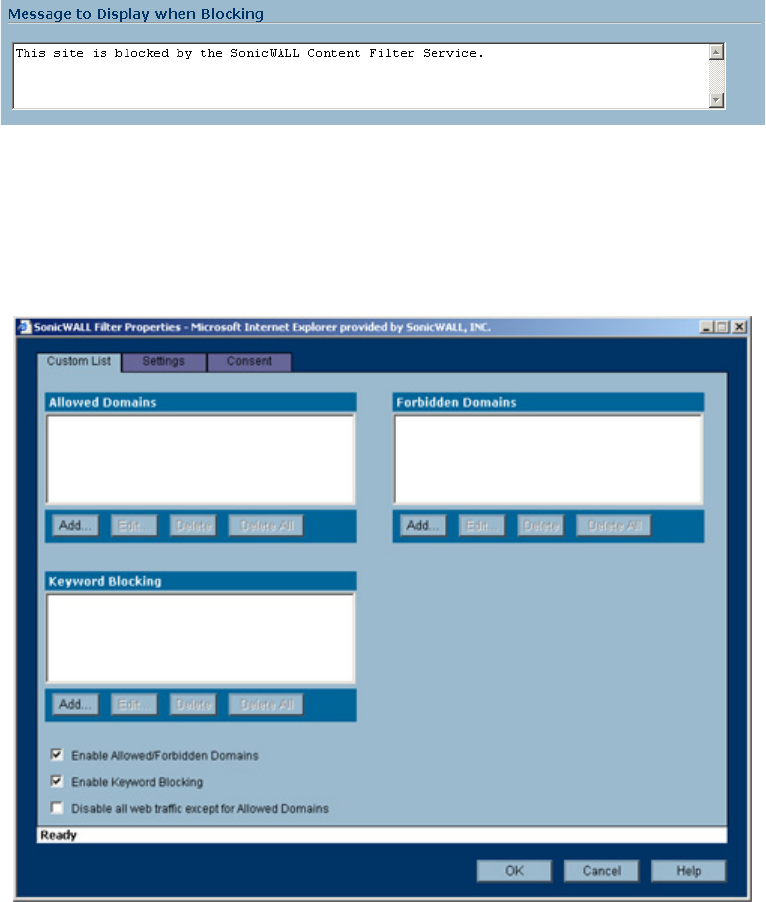
Security Services Page 73
Message to Display when Blocking
You can enter your customized text to display to the user when access to a blocked site is attempted. The
default message is This site is blocked by the SonicWALL Content Filter Service. Any message,
including embedded HTML, up to 255 characters long, can be entered in this field.
Configuring SonicWALL Filter Properties
You can customize SonicWALL filter features included with SonicOS from the SonicWALL Filter
Properties window. To display the SonicWALL Filter Properties window, select SonicWALL CFS from
the Content Filter Type menu on the Security Services>Content Filter page, and click Configure. The
SonicWALL Filter Properties window is displayed.
Custom List
You can customize your URL list to include Allowed Domains and Forbidden Domains. By customizing
your URL list, you can include specific domains to be accessed, blocked, and include specific keywords
to block sites. Select the check box Enable Allowed/Forbidden Domains to activate this feature.
To allow access to a Web site that is blocked by the Content Filter List, click Add, and enter the host
name, such as “www.ok-site.com”, into the Allowed Domains fields. 256 entries can be added to the
Allowed Domains list.
To block a Web site that is not blocked by the Content Filter Service, click Add, and enter the host name,
such as “www.bad-site.com” into the Forbidden Domains field. 256 entries can be added to the
Forbidden Domains list.
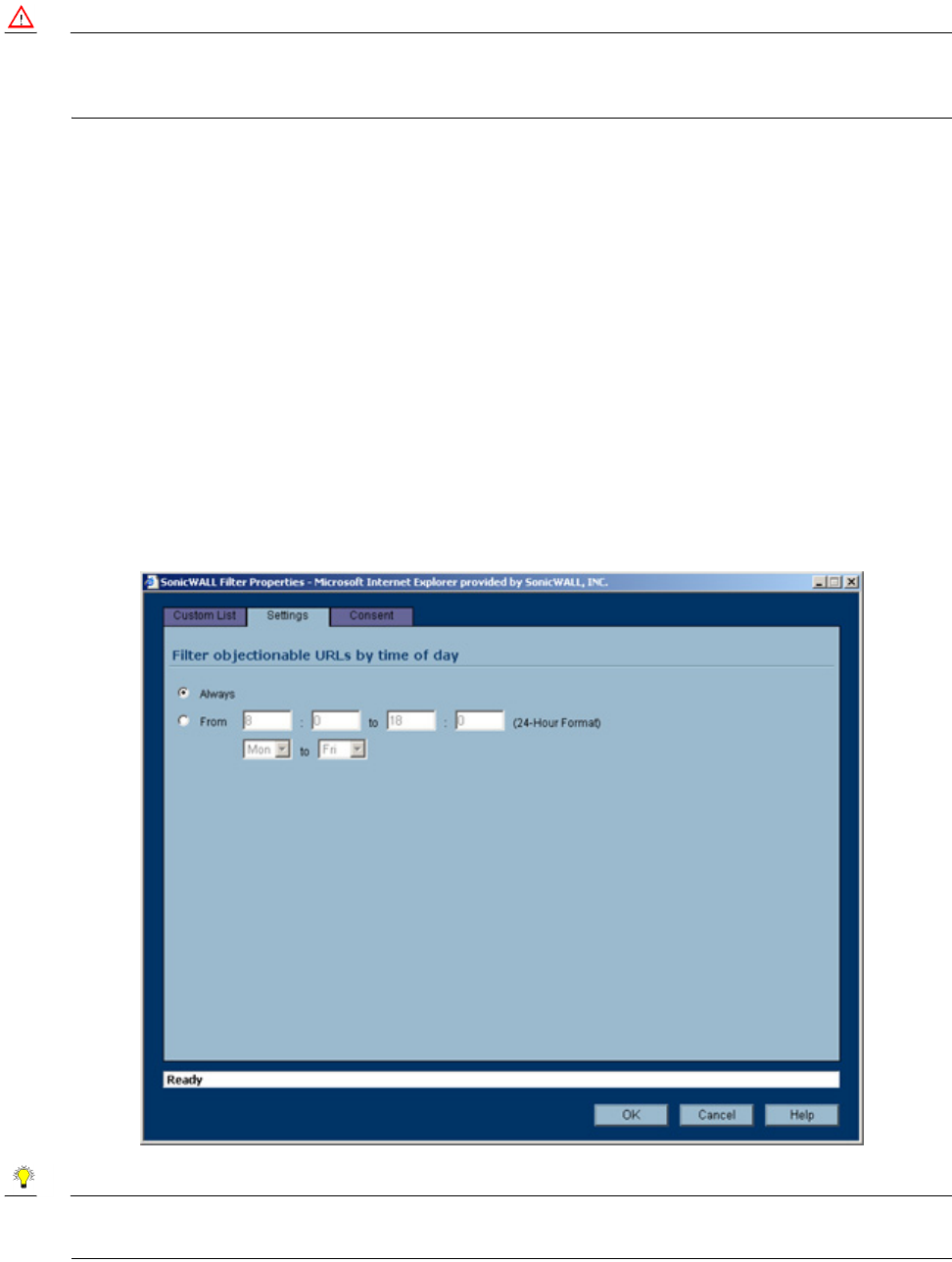
Page 74 SonicWALL SonicOS Standard Administrator’s Guide
Alert!
Do not include the prefix “http://” in either the Allowed Domains or Forbidden Domains the fields. All
subdomains are affected. For example, entering “yahoo.com” applies to “mail.yahoo.com” and
“my.yahoo.com”.
To remove a trusted or forbidden domain, select it from the appropriate list, and click Delete. Once the
domain has been deleted, the Status bar displays Ready.
Enable Keyword Blocking
To enable blocking using Keywords, select Enable Keyword Blocking.Click Add, and enter the
keyword to block in the Add Keyword field, and click OK.
To remove a keyword, select it from the list and click Delete. Once the keyword has been removed, the
Status bar displays Ready.
Disable all Web traffic except for Allowed Domains
When the Disable Web traffic except for Allowed Domains check box is selected, the SonicWALL only
allows Web access to sites on the Allowed Domains list. With careful screening, this can be nearly 100%
effective at blocking pornography and other objectionable material.
Settings
The Time of Day feature allows you to define specific times when Content Filtering is enforced. For
example, you could configure the SonicWALL to filter employee Internet access during normal business
hours, but allow unrestricted access at night and on weekends.
Tip!
Time of Day restrictions only apply to the Content Filtering Service. Customized blocking and Keyword
blocking. Consent and Restrict Web Features are not affected.
•Always - When selected, Content Filtering is enforced at all times.
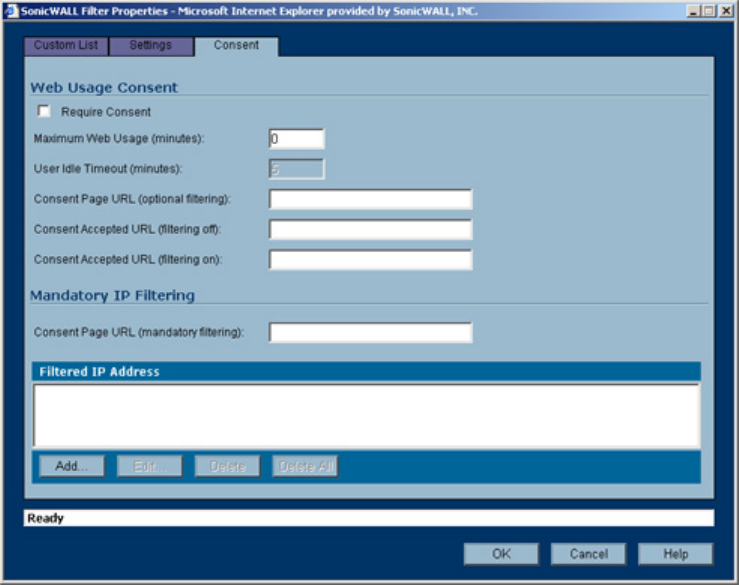
Security Services Page 75
• From - When selected, Content Filtering is enforced during the time and days specified. Enter the time
period, in 24-hour format, and select the starting and ending day of the week that Content Filtering is
enforced.
Consent
The Consent tab allows you to enforce content filtering on designated computers and provide optional
filtering on other computers. Consent can be configured to require the user to agree to the terms outlined
in an Acceptable Use Policy window before Web browsing is allowed.
To enable the Consent properties, select Require Consent.
•Maximum Web Usage (minutes) - In an environment where there are more users than computers,
such as a classroom or library, time limits are often imposed. The SonicWALL can be used to remind
users when their time has expired by displaying the page defined in the Consent page URL field. En-
ter the time limit, in minutes, in the Maximum Web usage field. When the default value of zero (0) is
entered, this feature is disabled.
• User Idle Timeout (minutes) - After a period of Web browser inactivity, the SonicWALL requires the
user to agree to the terms outlined in the Consent page before accessing the Internet again. To con-
figure the value, follow the link to the Users window and enter the desired value in the User Idle Time-
out section.
Page 76 SonicWALL SonicOS Standard Administrator’s Guide
•Consent Page URL (optional filtering) - When a user opens a Web browser on a computer requiring
consent, they are shown a consent page and given the option to access the Internet with or without
content filtering. This page must reside on a Web server and be accessible as a URL by users on the
network. It can contain the text from, or links to an Acceptable Use Policy (AUP). This page must con-
tain links to two pages contained in the SonicWALL, which, when selected, tell the SonicWALL if the
user wishes to have filtered or unfiltered access. The link for unfiltered access must be
<192.168.168.168/iAccept.html> and the link for filtered access must be <192.168.168.168/iAccept-
Filter.html>, where the SonicWALL LAN IP Address is used instead of 192.168.168.168"\.
•Consent Accepted URL (filtering off) - When a user accepts the terms outlined in the Consent
page and chooses to access the Internet without the protection of Content Filtering, they are shown
a Web page confirming their selection. Enter the URL of this page in the Consent Accepted (filtering
off) field. This page must reside on a Web server and be accessible as a URL by users on the net-
work.
•Consent Accepted URL (filtering on) - When a user accepts the terms outlined in the Consent page
and chooses to access the Internet with the protection of Content Filtering, they are shown a Web
page confirming their selection. Enter the URL of this page in the Consent Accepted (filtering on)
field. This page must reside on a Web server and be accessible as a URL by users on the network.
Mandatory Filtered IP Addresses
Consent Page URL (mandatory filtering)
When a user opens a Web browser on a computer using mandatory content filtering, a consent page is
displayed. You must create the Web page that appears when the Web browser is opened. It can contain
text from an Acceptable Use Policy, and notification that violations are logged or blocked.
This Web page must reside on a Web server and be accessible as a URL by users on the LAN. This page
must also contain a link to a page contained in the SonicWALL that tells the SonicWALL that the user
agrees to have filtering enabled. The link must be <192.168.168.168/iAcceptFilter.html>, where the
SonicWALL LAN IP Address is used instead of 192.168.168.168.
Enter the URL of this page in the Consent Page URL (mandatory filtering) field and click OK. Once the
SonicWALL has been updated, a message confirming the update is displayed at the bottom of the Web
browser window.
Adding a New Address
The SonicWALL can be configured to enforce content filtering for certain computers on the LAN. Click
Add to display the Add Filtered IP Address Entry window.
Enter the IP addresses of these computers in the Add New Address field and click Submit button. Up to
128 IP addresses can be entered.
To remove a computer from the list of computers to be filtered, highlight the IP address in the Mandatory
Filtered IP Addresses list and click Delete.
SonicWALL Network Anti-Virus
By their nature, anti-virus products typically require regular, active maintenance on every PC. When a new
virus is discovered, all anti-virus software deployed within an organization must be updated with the latest
virus definition files. Failure to do so severely limits the effectiveness of anti-virus software and disrupts
productive work time. With more than 50,000 known viruses and new virus outbreaks occurring regularly,
the task of maintaining and updating virus protection can become unwieldy. Unfortunately, many small to
medium businesses don’t have adequate IT staff to maintain their anti-virus software. The resulting gaps
in virus defenses may lead to data loss and decreased employee productivity.
The widespread outbreaks of viruses, such as NIMDA and Code Red, illustrate the problematic nature of
virus defense for small and medium businesses. Users without the most current virus definition files allow
these viruses to multiply and infect many other users and networks. SonicWALL Network Anti-Virus
prevents occurrences like these and offers a new approach to virus protection. The SonicWALL family of
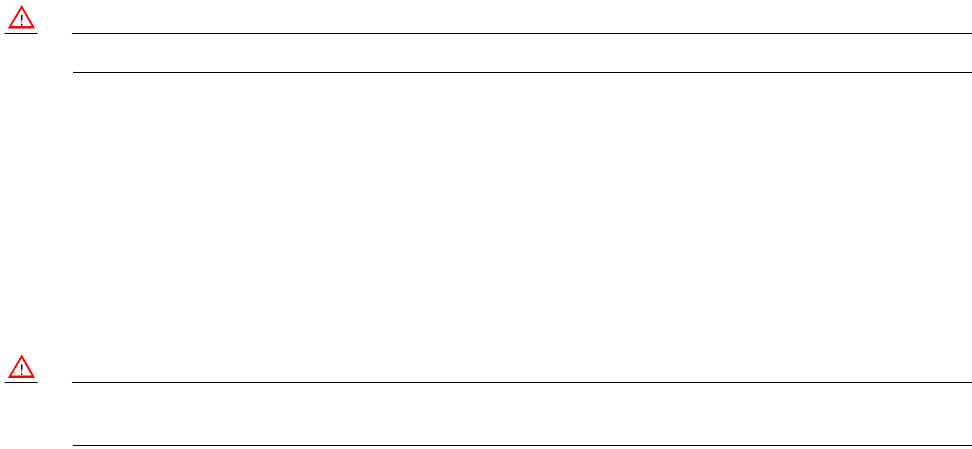
Security Services Page 77
firewalls constantly monitors the version of the virus definition file and automatically triggers download and
installation of new virus definition files to each user’s computer. In addition, the SonicWALL restricts each
user’s access to the Internet until they are protected, therefore acting as an enforcer of the company’s
virus protection policy. This new approach ensures the most current version of the virus definition file is
installed and active on each PC on the network, preventing a rogue user from disabling the virus
protection and potentially exposing the entire organization to an outbreak.
Alert!
You must purchase an Anti-Virus subscription to enforce Anti-Virus through the SonicWALL.
Security Services>Anti-Virus
If SonicWALL Network Anti-Virus is not activated, you must activate it. If you do not have an Activation
Key, you must purchase SonicWALL Network Anti-Virus from a SonicWALL reseller or from your
mySonicWALL.com account (limited to customer in the USA and Canada).
Activating SonicWALL Network Anti-Virus
If you have an Activation Key for your SonicWALL Network Anti-Virus subscription, follow these steps to
activate SonicWALL Network Anti-Virus:
Alert!
You must have a mySonicWALL.com account and your SonicWALL must be registered to activate
SonicWALL Network Anti-Virus.
1. Click the SonicWALL Network Anti-Virus Subscription link on the Security Services>Anti-Virus
page. The mySonicWALL.com Login page is displayed.
2. Enter your mySonicWALL.com account username and password in the User Name and Password
fields, then click Submit. The System>Licenses page is displayed. If your SonicWALL is already
connected to your mySonicWALL.com account, the System>Licenses page appears after you click
the SonicWALL Network Anti-Virus Subscription link.
3. Click Activate or Renew in the Manage Service column in the Manage Services Online table. Type
in the Activation Key in the New License Key field and click Submit. Your SonicWALL Network Anti-
Virus subscription is activated on your SonicWALL.
If you activated SonicWALL Network Anti-Virus at www.mySonicWALL.com, the SonicWALL Network
Anti-Virus activation is automatically enabled on your SonicWALL within 24-hours or you can click the
Synchronize button on the Security Services>Summary page to update your SonicWALL.
Activating a SonicWALL Network Anti-Virus FREE TRIAL
You can try a FREE TRIAL of SonicWALL Network Anti-Virus by following these steps:
1. Click the FREE TRIAL link. The mySonicWALL.com Login page is displayed.
2. Enter your mySonicWALL.com account username and password in the User Name and Password
fields, then click Submit. The System>Licenses page is displayed. If your SonicWALL is already
connected to your mySonicWALL.com account, the System>Licenses page appears after you click
the FREE TRIAL link.
3. Click FREE TRIAL in the Manage Service column in the Manage Services Online table. Your
SonicWALL Network Anti-Virus subscription is activated on your SonicWALL.

Page 78 SonicWALL SonicOS Standard Administrator’s Guide
Network Anti-Virus E-Mail Filter
The E-Mail Filter allows the administrator to selectively delete or disable inbound e-mail attachments as
they pass through the SonicWALL. This feature provides control over executable files and scripts, and
applications sent as e-mail attachments.
Note:
E-Mail Filter is included with Network Anti-Virus.
Intrusion Prevention Service
SonicWALL Intrusion Prevention Service (SonicWALL IPS) delivers a configurable, high performance
Deep Packet Inspection engine for extended protection of key network services such as Web, e-mail, file
transfer, Windows services and DNS. SonicWALL IPS is designed to protect against application
vulnerabilities as well as worms, Trojans, and peer-to-peer, spyware and backdoor exploits. The
extensible signature language used in SonicWALL’s Deep Packet Inspection engine also provides
proactive defense against newly discovered application and protocol vulnerabilities. SonicWALL IPS
offloads the costly and time-consuming burden of maintaining and updating signatures for new hacker
attacks through SonicWALL’s industry-leading Distributed Enforcement Architecture (DEA). Signature
granularity allows SonicWALL IPS to detect and prevent attacks based on a global, attack group, or per-
signature basis to provide maximum flexibility and control false positives.
Note:
SonicWALL Intrusion Prevention Service is available for the SonicWALL TZ 170 and PRO Series (PRO
2040, PRO 3060, PRO 4060, and PRO 5060) SonicWALL Internet Security Appliances running
SonicOS Standard or Enhanced 2.2 (or higher).
SonicWALL IPS Features
•High Performance Deep Packet Inspection Technology - SonicWALL’s Intrusion Prevention
Service features a configurable, high-performance Deep Packet Inspection engine that uses parallel
searching algorithms on incoming packets through the application layer to deliver increased attack
prevention capabilities over those supplied by traditional stateful packet inspection firewall. By
performing all of the matching on packets, SonicWALL IPS eliminates the overhead of having to
reassemble the data stream. Parallel processing reduces the impact on the processor and maximizes
available memory for exceptional performance on SonicWALL appliances.
•Inter-Zone Intrusion Prevention - SonicWALL IPS provides an additional layer of protection against
malicious threats by allowing administrator’s to enforce intrusion prevention not only between each
network zone and the Internet, but also between internal network zones. This is performed by
enabling intrusion prevention on inbound and outbound traffic between trusted zones (SonicOS
Enhanced).
•Extensive Signature Database - SonicWALL IPS utilizes an extensive database of over 1,700 attack
and vulnerability signatures written to detect and prevent intrusions, worms, application exploits, as
well as peer-to-peer and instant messaging traffic. The SonicWALL Deep Packet Inspection engine
can also read signatures written in the popular Snort format, allowing SonicWALL to easily
incorporate new signatures as they are published by third parties. SonicWALL maintains a current
and robust signature database by incorporating the latest available signatures from thousands of
open source developers and by continually developing new signatures for application vulnerabilities
that are not immediately available or provided by open source.
•Dynamically Updated Signature Database - SonicWALL IPS includes automatic signature updates
delivered through SonicWALL’s Distributed Enforcement Architecture (DEA), providing protection
Security Services Page 79
from emerging threats and lowering total cost of ownership. Updates to the signature database are
dynamic for SonicWALL firewalls under an active subscription.
•Scalable - SonicWALL IPS is a scalable solution for SonicWALL TZ 170 and PRO Series Appliances
that secures small, medium and large networks with complete protection from application exploits,
worms and malicious traffic.
•Application Control - SonicWALL IPS provides the ability to prevent Instant Messaging and Peer-
to-Peer file sharing programs from operating through the firewall, closing a potential backdoor that
can be used to compromise the network while also improving employee productivity and conserving
Internet bandwidth.
•Simplified Deployment and Management - SonicWALL IPS allows network administrators to
quickly and easily manage the service within minutes. Administrator’s can create global policies
between security zones and interfaces as well as group attacks by priority, simplifying deployment
and management across a distributed network.
•Granular Policy Management - SonicWALL IPS provides administrators with a range of granular
policy tools to enforce IPS on a global, group, or individual signature level to enable more control and
reduce the number of false policies. SonicWALL IPS allows also allows administrators to choose
between detection, prevention, or both to tailor policies for their specific network environment.
•Logging and Reporting - SonicWALL IPS offers comprehensive logging of all intrusion attempts with
the ability to filter logs based on priority level, enabling administrator’s to highlight high priority attacks.
Granular reporting based on attack source, destination and type of intrusion is available through
SonicWALL ViewPoint and Global Management System. A hyperlink of the intrusion brings up the
signature window for further information from the SonicWALL appliance log.
•Management by Risk Category - SonicWALL IPS allows you to enable/disable detection or
prevention based on the priority level of attack through High, Medium, or Low predefined priority
groups.
•Detection Accuracy - SonicWALL IPS detection and prevention accuracy is achieved minimizing
both false positives and false negatives. Signatures are written around applications, such as Internet
Explorer or SQL Server rather than ports or protocols to ensure that malicious code targeting them
are correctly identified and prevented.
SonicWALL Deep Packet Inspection
Deep Packet Inspection looks at the data portion of the packet. The Deep Packet Inspection technology
includes intrusion detection and intrusion prevention. Intrusion detection finds anomalies in the traffic and
alerts the administrator. Intrusion prevention finds the anomalies in the traffic and reacts to it, preventing
the traffic from passing through.
Deep Packet Inspection is a technology that allows a SonicWALL Security Appliance to classify passing
traffic based on rules. These rules include information about layer 3 and layer 4 content of the packet as
well as the information that describes the contents of the packet’s payload, including the application data
(for example, an FTP session, an HTTP Web browser session, or even a middleware database
connection). This technology allows the administrator to detect and log intrusions that pass through the
SonicWALL Security Appliance, as well as prevent them (i.e. dropping the packet or resetting the TCP
connection). SonicWALL’s Deep Packet Inspection technology also correctly handles TCP fragmented
byte stream inspection as if no TCP fragmentation has occurred.
How SonicWALL’s Deep Packet Inspection Architecture Works
Deep Packet Inspection technology enables the firewall to investigate farther into the protocol to examine
information at the application layer and defend against attacks targeting application vulnerabilities. This
is the technology behind SonicWALL Intrusion Prevention Service. SonicWALL’s Deep Packet Inspection
technology enables dynamic signature updates pushed from the SonicWALL Distributed Enforcement
Architecture.
The following steps describe how the SonicWALL Deep Packet Inspection Architecture works:
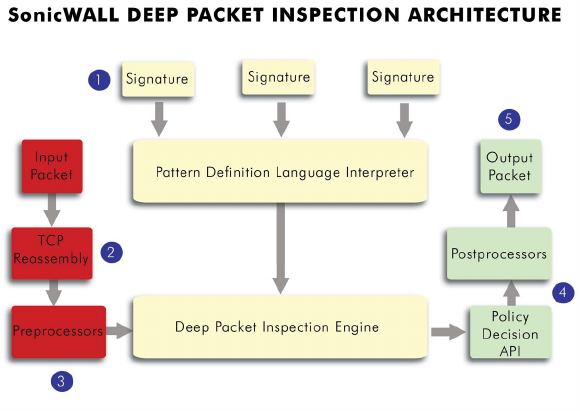
Page 80 SonicWALL SonicOS Standard Administrator’s Guide
1. Pattern Definition Language Interpreter uses signatures that can be written to detect and prevent
against known and unknown protocols, applications and exploits.
2. TCP packets arriving out-of-order are reassembled by the Deep Packet Inspection framework.
3. Deep Packet Inspection engine preprocessing involves normalization of the packet’s payload. For
example, a HTTP request may be URL encoded and thus the request is URL decoded in order to
perform correct pattern matching on the payload.
4. Deep Packet Inspection engine postprocessors perform actions which may either simply pass the
packet without modification, or could drop a packet or could even reset a TCP connection.
5. SonicWALL’s Deep Packet Inspection framework supports complete signature matching across the
TCP fragments without performing any reassembly (unless the packets are out of order). This results
in more efficient use of processor and memory for greater performance.
SonicWALL IPS Terminology
•Stateful Packet Inspection - looking at the header of the packet to control access based on port,
protocol, and IP address.
•Deep Packet Inspection - looking at the data portion of the packet. Enables the firewall to investigate
farther into the protocol to examine information at the application layer and defend against attacks
targeting application vulnerabilities.
•Intrusion Detection - a process of identifying and flagging malicious activity aimed at information
technology.
•False Positive - a falsely identified attack traffic pattern.
•Intrusion Prevention - finding anomalies and malicious activity in traffic and reacting to it.
•Snort - an open source network intrusion detection system. SonicWALL IPS includes open-source
Snort signatures, as well as signatures from other signature databases, and SonicWALL created
signatures. SonicWALL does not use the Snort engine.
•Signature - code written to detect and prevent intrusions, worms, application exploits, and Peer-to-
Peer and Instant Messaging traffic.

Security Services Page 81
SonicWALL IPS Activation
If you do not have SonicWALL IPS activated on your SonicWALL, you must purchase SonicWALL IPS
from a SonicWALL reseller or through your mySonicWALL.com account (limited to customers in the USA
and Canada).
If you do not have SonicWALL IPS installed on your SonicWALL, the Security Services>Intrusion
Prevention page indicates an upgrade is required and includes a link to activate your IPS subscription
from the SonicWALL Management Interface or to activate a FREE TRIAL of SonicWALL IPS.
Note:
You must have SonicOS Standard or Enhanced 2.2 (or higher) to activate SonicWALL IPS, and your
SonicWALL must be registered on https://www.mySonicwall.com.
mySonicWALL.com
mySonicWALL.com delivers a convenient, one-stop resource for registration, activation, and
management of your SonicWALL products and services. Your mySonicWALL.com account provides a
single profile to do the following:
• Register your SonicWALL Internet Security Appliances
• Purchase/Activate SonicWALL Security Services and Upgrades
• Receive SonicWALL firmware and security service updates and alerts
• Manage (change or delete) your SonicWALL security services
• Access SonicWALL Technical Support
Creating a mySonicWALL.com account is easy and free. Simply complete an online registration form.
Once your account is created, you can register SonicWALL Internet Security Appliances and activate any
SonicWALL Security Services associated with the SonicWALL.
Your mySonicWALL.com account is accessible from any Internet connection with a Web browser using
the HTTPS (Hypertext Transfer Protocol Secure) protocol to protect your sensitive information. You can
also access mySonicWALL.com license and registration services directly from the SonicWALL
management interface for increased ease of use and simplified services activation.
If you activated SonicWALL IPS at mySonicWALL.com, the SonicWALL IPS activation is automatically
enabled on your SonicWALL within 24-hours or you can click the Synchronize button on the Security
Services>Summary page to update your SonicWALL.
Activating SonicWALL IPS
If you have an Activation Key for your SonicWALL IPS, follow these steps to activate IPS:
1. Click the SonicWALL IDP Subscription link on the Security Services>Intrusion Prevention page.
The mySonicWALL.com Login page is displayed.
2. Enter your mySonicWALL.com account username and password in the User Name and Password
fields, then click Submit. The System>Licenses page is displayed. If your SonicWALL is already
registered to your mySonicWALL.com account, the System>Licenses page appears after you click
the SonicWALL IPS Subscription link.
3. Click Activate or Renew in the Manage Service column in the Manage Services Online table. Type
in the Activation Key in the New License Key field and click Submit. Your SonicWALL IPS
subscription is activated on your SonicWALL.
If you activated the SonicWALL IPS subscription on mySonicWALL.com, the SonicWALL IPS activation
is automatically enabled on your SonicWALL within 24-hours or you can click the Synchronize button on
the Security Services>Summary page to update your SonicWALL.
Page 82 SonicWALL SonicOS Standard Administrator’s Guide
Activating the SonicWALL IPS FREE TRIAL
To try a FREE TRIAL of SonicWALL IPS, follow these steps:
1. Click the FREE TRIAL link. The mySonicWALL.com Login page is displayed.
2. Enter your mySonicWALL.com account username and password in the User Name and Password
fields, then click Submit. The System>Licenses page is displayed. If your SonicWALL is already
connected to your mySonicWALL.com account, the System>Licenses page appears after you click
the FREE TRIAL link.
3. Click FREE TRIAL in the Manage Service column in the Manage Services Online table. Your
SonicWALL IPS trial subscription is activated on your SonicWALL.
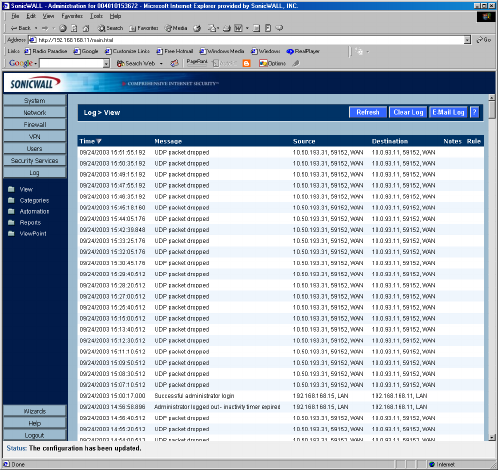
Log Page 83
12 Log
The SonicWALL Internet security appliance provides logging, alerting, and reporting features, which can
be viewed in the Log section of the SonicWALL Web Management Interface.
Log>View
The SonicWALL maintains an Event log which displays potential security threats. This log can be viewed
with a browser using the SonicWALL Web Management Interface, or it can be automatically sent to an e-
mail address for convenience and archiving. The log is displayed in a table and can be sorted by column.
The SonicWALL can alert you of important events, such as an attack to the SonicWALL. Alerts are
immediately e-mailed, either to an e-mail address or to an e-mail pager. Each log entry contains the date
and time of the event and a brief message describing the event.
Click Log on the left side of the browser window. The default view is Log>View.
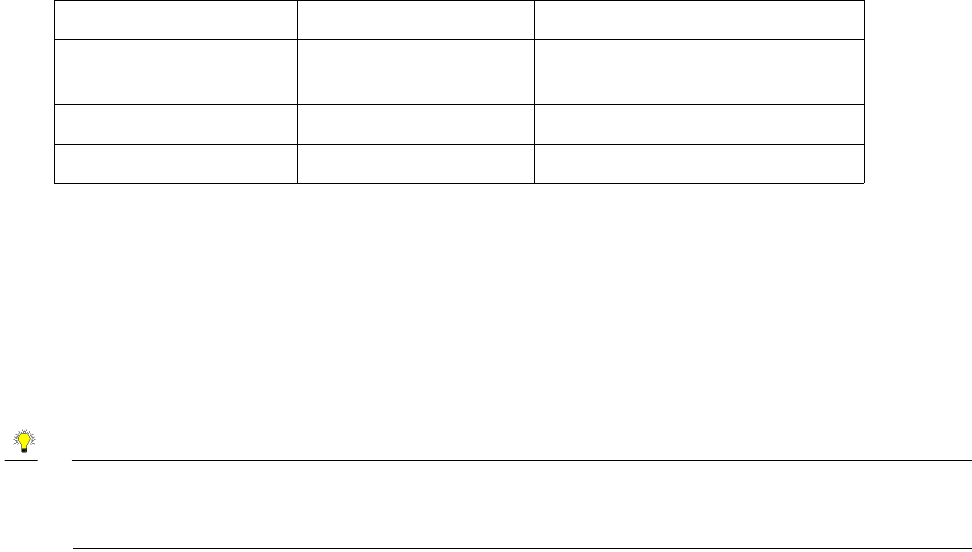
Page 84 SonicWALL SonicOS Standard Administrator’s Guide
SonicWALL Log Messages
Each log entry contains the date and time of the event and a brief message describing the event. It is also
possible to copy the log entries from the management interface and paste into a report.
•Dropped TCP, UDP, or ICMP packets
When IP packets are blocked by the SonicWALL, dropped TCP, UDP and ICMP messages are
displayed. The messages include the source and destination IP addresses of the packet. The TCP or
UDP port number or the ICMP code follows the IP address. Log messages usually include the name
of the service in quotation marks.
•Blocked Web Sites
When a computer attempts to connect to the blocked site or newsgroup, a log event is displayed. The
computer’s IP address, Ethernet address, the name of the blocked Web site, and the Content Filter
List Code is displayed. Code definitions for the 12 Content Filter List categories are displayed in the
table below:
Descriptions of the categories are available at <http://www.sonicwall.com/products/cfs.html>.
•Blocked Java, etc.
When ActiveX, Java or Web cookies are blocked, messages with the source and destination IP
addresses of the connection attempt is displayed.
•Ping of Death, IP Spoof, and SYN Flood Attacks
The IP address of the machine under attack and the source of the attack is displayed. In most attacks,
the source address shown is fake and does not reflect the real source of the attack.
Tip!
Some network conditions can produce network traffic that appears to be an attack, even if no one is
deliberately attacking the LAN. Verify the log messages with SonicWALL Tech Support before
contacting your ISP to determine the source of the attack.
Clear Log
Clicking Clear Log deletes the contents of the log.
E-mail Log
If you have configured the SonicWALL to e-mail log files, clicking E-mail Log sends the current log files
to the e-mail address specified in the Log>Automation>E-mail section.
1. Violence/Hate/Racism 5. Weapons 9. Illegal Skills/Questionable Skills
2. Intimate Apparel/
Swimsuit
6. Adult/Mature Content 10. Sex Education
3. Nudism 7. Cult/Occult 11. Gambling
4. Pornography 8. Drugs/Illegal Drugs 12. Alcohol/Tobacco
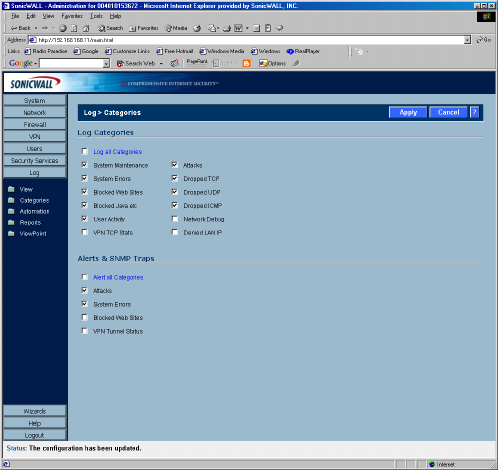
Log Page 85
Log>Categories
You can define which log messages appear in the SonicWALL Event Log.
Log Categories
All Log Categories are enabled by default except Network Debug.
•Log all Categories
Select Log all Categories to begin logging all event categories.
•System Maintenance
Logs general system activity, such as system activations.
•System Errors
Logs problems with DNS, or e-mail.
•Blocked Web Sites
Logs Web sites or newsgroups blocked by the Content Filter List or by customized filtering.
•Blocked Java, etc.
Logs Java, ActiveX, and Cookies blocked by the SonicWALL.
•User Activity
Logs successful and unsuccessful log in attempts.
•VPN TCP Stats
Logs TCP connections over VPN tunnels.
•System Environment (PRO 3060)
Logs events about fan failure, overheating, and any hardware issues.
•Attacks
Logs messages showing Denial of Service attacks, such as SYN Flood, Ping of Death, and IP
spoofing.
•Dropped TCP
Logs blocked incoming TCP connections.
Page 86 SonicWALL SonicOS Standard Administrator’s Guide
•Dropped UDP
Logs blocked incoming UDP packets.
•Dropped ICMP
Logs blocked incoming ICMP packets.
•Network Debug
Logs NetBIOS broadcasts, ARP resolution problems, and NAT resolution problems. Also, detailed
messages for VPN connections are displayed to assist the network administrator with troubleshooting
problems with active VPN tunnels. Network Debug information is intended for experienced network
administrators.
•Denied LAN IP
Logs all LAN IP addresses denied by the SonicWALL.
Alerts & SNMP Traps
Alerts are events, such as attacks, which warrant immediate attention. When events generate alerts,
messages are immediately sent to the e-mail address defined in the Send alerts to field. Attacks and
System Errors are enabled by default, Blocked Web Sites and VPN Tunnel Status are disabled.
•Alert all Categories
Select Alert all Categories to begin logging of all alert categories.
•Attacks
Log entries categorized as Attacks generate alert messages.
•System Errors
Log entries categorized as System Errors generate alert messages.
•Blocked Web Sites
Log entries categorized as Blocked Web Sites generate alert messages.
•VPN Tunnel Status
Log entries categorized as VPN Tunnel Status generate alert messages.
•System Environment (PRO 3060)
Logs events about fan failure, overheating, and any hardware issues.
Once you have configured the Log Categories window, click Apply. Once the SonicWALL is updated, a
message confirming the update is displayed at the bottom of the browser window.
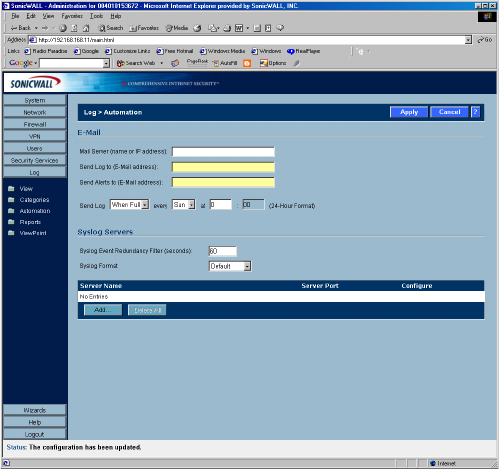
Log Page 87
Log>Automation
Click Log, and then Automation to begin configuring the SonicWALL to send log files using
e-mail and configuring syslog servers on your network.
E-mail
1. Mail Server - to e-mail log or alert messages, enter the name or IP address of your mail server in the
Mail Server field. If this field is left blank, log and alert messages are not
e-mailed.
2. Send Log To - enter your full e-mail address in the Send log to field to receive the event log via e-
mail. Once sent, the log is cleared from the SonicWALL memory. If this field is left blank, the log is
not e-mailed.
3. Send Alerts To - enter your full e-mail address (username@mydomain.com) in the Send alerts to
field to be immediately e-mailed when attacks or system errors occur. Enter a standard e-mail
address or an e-mail paging service. If this field is left blank, e-mail alert messages are not sent.
4. Send Log / Every / At - The Send Log menu determines the frequency of log e-mail messages:
Daily, Weekly, or When Full. If the Weekly or Daily option is selected, then select the day of the
week the e-mail is sent in the Every menu. If the Weekly or the Daily option is selected, enter the
time of day when the e-mail is sent in the At field.
Syslog Servers
In addition to the standard event log, the SonicWALL can send a detailed log to an external Syslog server.
The SonicWALL Syslog captures all log activity and includes every connection source and destination IP
address, IP service, and number of bytes transferred. The SonicWALL Syslog support requires an
external server running a Syslog daemon on UDP Port 514.
Syslog Analysers such as SonicWALL ViewPoint or WebTrends Firewall Suite can be used to sort,
analyse, and graph the Syslog data.
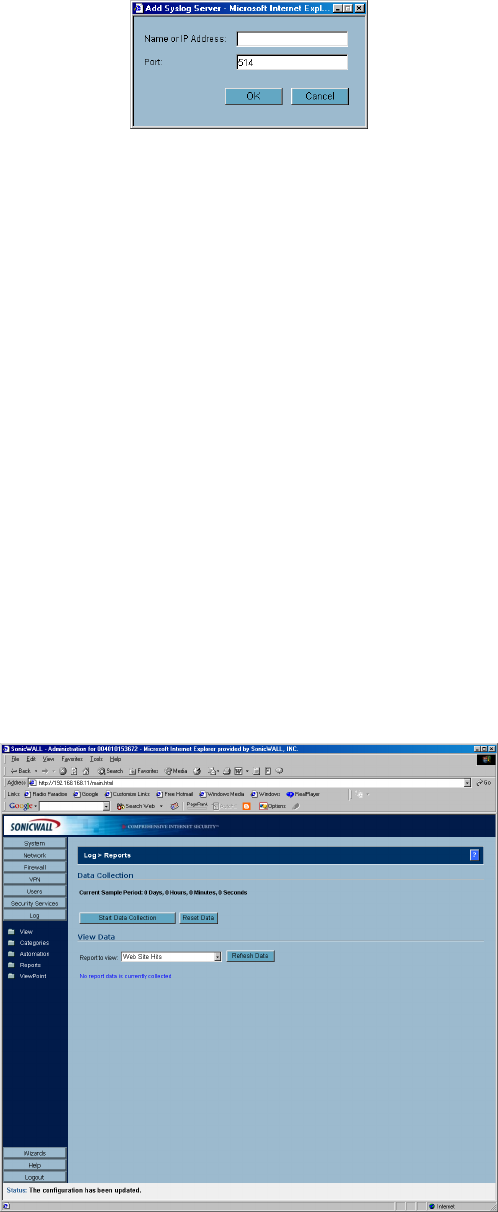
Page 88 SonicWALL SonicOS Standard Administrator’s Guide
To add syslog servers to the SonicWALL, click Add. The Add Syslog Server window is displayed.
1. Enter the Syslog server name or IP address in the Name or IP Address field. Messages from the
SonicWALL are then sent to the servers. Up to three Syslog Server IP addresses can be added.
2. If your syslog is not using the default port of 514, enter the port number in the Port Number field.
3. Click OK.
If the SonicWALL is managed by SGMS, however, the Syslog Server fields cannot be configured by the
administrator of the SonicWALL.
Syslog Event Redundancy Filter (seconds) - The Syslog Event Redundancy Filter setting prevents
repetitive messages from being written to Syslog. If duplicate events occur during the period specified in
the Syslog Event Redundancy Rate field, they are not written to Syslog as unique events. Instead, the
additional events are counted, and then at the end of the period, a message is written to the Syslog that
includes the number of times the event occurred.
The Syslog Event Redundancy Rate default value is 60 seconds and the maximum value is 86,400
seconds (24 hours). Setting this value to 0 seconds sends all Syslog messages without filtering.
Syslog Format - You can choose the format of the Syslog to be Default or WebTrends. If you select
WebTrends, however, you must have WebTrends software installed on your system.
Log>Reports
The SonicWALL can perform a rolling analysis of the event log to show the top 25 most frequently
accessed Web sites, the top 25 users of bandwidth by IP address, and the top 25 services consuming the
most bandwidth. Click Log on the left side of the browser window, and then click the Reports.
Log Page 89
Data Collection
The Reports page includes the following functions and commands:
•Start Data Collection
Click Start Data Collection to begin log analysis. When log analysis is enabled, the button label
changes to Stop Data Collection.
•Reset Data
Click Reset Data to clear the report statistics and begin a new sample period. The sample period is
also reset when data collection is stopped or started, and when the SonicWALL is restarted.
View Data
Select the desired report from the Report to view menu. The options are Web Site Hits, Bandwidth
Usage by IP Address, and Bandwidth Usage by Service. These reports are explained below. Click
Refresh Data to update the report. The length of time analysed by the report is displayed in the Current
Sample Period.
Web Site Hits
Selecting Web Site Hits from the Report to view menu displays a table showing the URLs for the 25
most frequently accessed Web sites and the number of hits to a site during the current sample period.
The Web Site Hits report ensures that the majority of Web access is to appropriate Web sites. If leisure,
sports, or other inappropriate sites appear in the Web Site Hits Report, you can choose to block the sites.
Bandwidth Usage by IP Address
Selecting Bandwidth Usage by IP Address from the Report to view menu displays a table showing the
IP Address of the 25 top users of Internet bandwidth and the number of megabytes transmitted during the
current sample period.
Bandwidth Usage by Service
Selecting Bandwidth Usage by Service from the Report to view menu displays a table showing the
name of the 25 top Internet services, such as HTTP, FTP, RealAudio, etc., and the number of megabytes
received from the service during the current sample period.
The Bandwidth Usage by Service report shows whether the services being used are appropriate for
your organization. If services such as video or push broadcasts are consuming a large portion of the
available bandwidth, you can choose to block these services.

Page 90 SonicWALL SonicOS Standard Administrator’s Guide
Log>ViewPoint
SonicWALL ViewPoint
SonicWALL ViewPoint is a software solution that creates dynamic, Web-based reports of network activity.
ViewPoint generates both real-time and historical reports to provide a complete view of all activity through
your SonicWALL Internet Security Appliance. With SonicWALL ViewPoint, you are able to monitor
network access, enhance network security and anticipate future bandwidth needs.
• Displays bandwidth use by IP address and service.
• Identifies inappropriate Web use.
• Presents detailed reports of attacks.
• Collects and aggregates system and network errors.
Tip!
You can try a FREE trial of ViewPoint. Go to the Security Services>Summary page to access the trial
version of ViewPoint
Note:
For complete instructions on configuring and managing SonicWALL ViewPoint, see the SonicWALL
ViewPoint User’s Guide, available at www.sonicwall.com/services/ViewPoint_documentation.html.

Appendices Page 91
13 Appendices
Appendix A - SonicWALL Support Solutions
SonicWALL’s powerful security solutions give unprecedented protection from the risks of Internet attacks.
SonicWALL’s comprehensive support services protect your network security investment and offer the
support you need - when you need it.
Note: For more information on SonicWALL Support Solutions, please visit
<http://www.sonicwall.com/products/services/support.html>.
Knowledge Base
All SonicWALL customers have immediate, 24X7 access to our state-of-the-art electronic support tools.
Power searching technologies on our Web site allow customers to locate information quickly and easily
from our robust collection of technical information - including manuals, product specifications, operating
instructions, FAQs, Web pages, and known solutions to common customer questions and challenges.
Internet Security Expertise
Technical Support is only as good as the people providing it to you. SonicWALL support professionals are
Certified Internet Security Administrators with years of experience in networking and Internet security.
They are also supported by the best in class tools and processes that ensure a quick and accurate
solution to your problem.
SonicWALL Support Programs
SonicWALL offers a variety of support programs designed to get the support you need when you need it.
For more information on SonicWALL Support Services, please visit
<http://www.sonicwall.com/products/supportservices.html.
Warranty Support - North America and International
SonicWALL products are recognized as extremely reliable as well as easy to configure, install, and
manage. SonicWALL Warranty Support enhances these features with
• 1 year, factory replacement for defective hardware
• 90 days of advisory support for installation and configuration assistance during local
business hours
• 90 days of software and firmware updates
• Access to SonicWALL’s electronic support and Knowledge Base system.
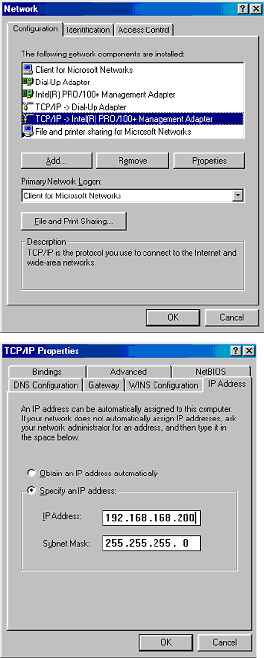
Page 92 SonicWALL SonicOS Standard Administrator’s Guide
Appendix B- Configuring the Management Station
TCP/IP Settings
The following steps describe how to configure the Management Station TCP/IP settings in order to initially
contact the SonicWALL. It is assumed that the Management Station can access the Internet through an
existing connection.
The SonicWALL is pre-configured with the IP address 192.168.168.168. During the initial configuration, it
is necessary to temporarily change the IP address of the Management Station to one in the same subnet
as the SonicWALL. For initial configuration, set the IP address of the Management Station to
192.168.168.200.
Make a note of the Management Station's current TCP/IP settings. If the Management Station accesses
the Internet through an existing broadband connection, then the TCP/IP settings can be helpful when
configuring the IP settings of the SonicWALL.
Windows 98
1.From the Start list, highlight Settings and then select Control
Panel.Double-click the Network icon in the Control Panel window.
2.Double-click TCP/IP in the TCP/IP Properties window.
3.Select Specify an IP Address.
4.Type "192.168.168.200" in the IP Address field.
5.Type "255.255.255.0" in the Subnet Mask field.
6.Click DNS Configuration.
7.Type the DNS IP address in the Preferred DNS Server
field. If you have more than one address, type the second one in
the Alternate DNS server field.
8.Click OK, and then click OK again.
9.Restart the computer for changes to take effect.
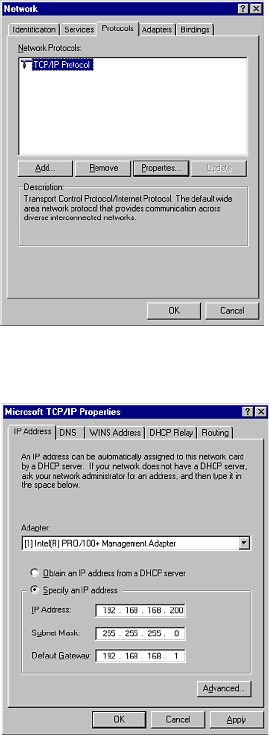
Appendices Page 93
Windows NT
1.From the Start list, highlight Settings and then select Control
Panel.
2.Double-click the Network icon in the Control Panel window.
3.Double-click TCP/IP in the TCP/IP Properties window.
4.Select Specify an IP Address.
5.Type "192.168.168.200" in the IP Address field.
6.Type "255.255.255.0" in the Subnet Mask field.
7.Click DNS at the top of the window.
8.Type the DNS IP address in the Preferred DNS Server field.
If you have more than one address, enter the second one in the
Alternate DNS server field.
9.Click OK, and then click OK again.

Page 94 SonicWALL SonicOS Standard Administrator’s Guide
Windows 2000
1.In Windows 2000, click Start, then Settings.
2.Click Network and Dial-up Connections. Double-click the
network connection name to open the Status window.
3.Click Status to open the Properties window.
4.Double-click Internet Protocol (TCP/IP) to open the TCP/IP
properties window.
5.Select Use the following IP address and enter
192.168.168.200 in the IP address field.
6.Type 255.255.255.0 in the Subnet mask field.
7.Type the DNS IP address in the Preferred DNS Server field. If
you have more than one address, enter the second one in the
Alternate DNS server field.
8.Click OK, then OK again.
9.Click Close to finish the network configuration.
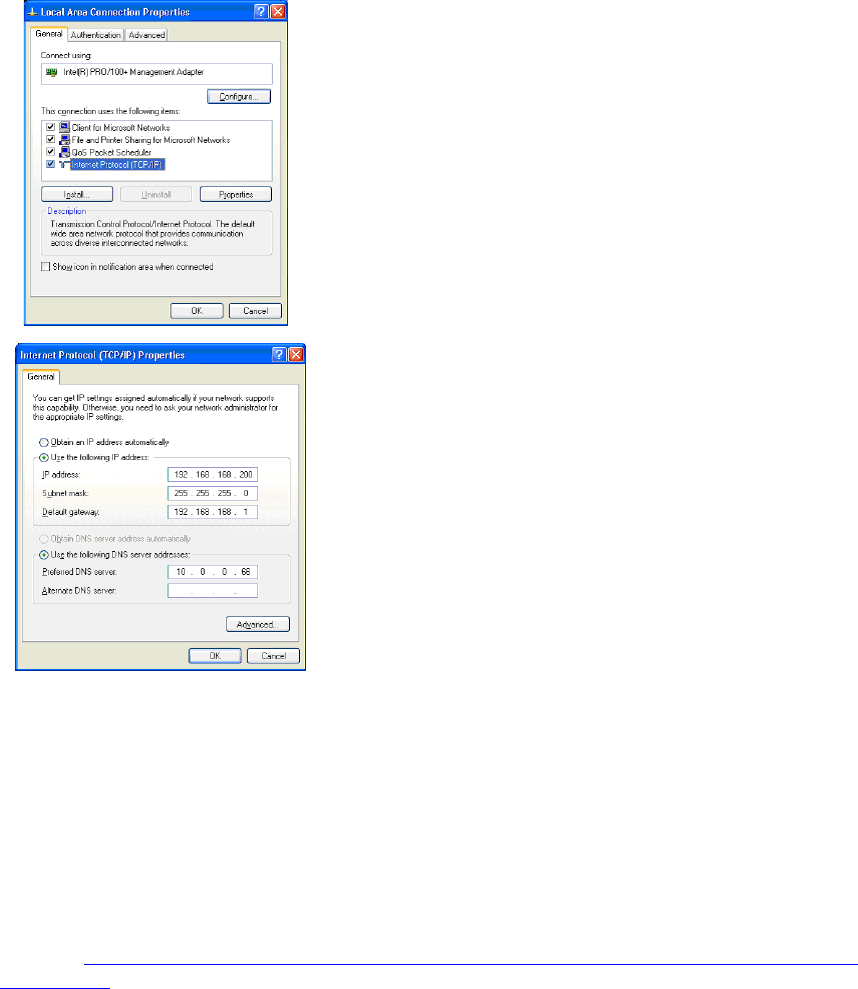
Appendices Page 95
Windows XP
1.Open the Local Area Connection Properties window.
2.Double-click Internet Protocol (TCP/IP) to open the
Internet Protocol (TCP/IP) Properties window.
3.Select Use the following IP address and type
192.168.168.200 in the IP address field.
4.Type 255.255.255.0 in the Subnet Mask field.
5.Type the DNS IP address in the Preferred DNS Server field.
If you have more than one address, type the second one in the
Alternate DNS server field.
6.Click OK for the settings to take effect on the computer.
Macintosh OS 10
From a Macintosh computer, do the following:
1. From the Apple list, choose Control Panel, and then choose TCP/IP to open the TCP/IP Control
Panel.
2. From the Configure list, choose Manually.
3. Type "192.168.168.200" in the IP address field.
4. Type the Subnet Mask address in the Subnet Mask field.
5. Click OK.Follow the SonicWALL Installation Wizard instructions to perform the initial setup of the
SonicWALL.
Page 96 SonicWALL SonicOS Standard Administrator’s Guide
Page 97
Index
A
Access Point Status 109
Access Rules 11
Adding Rules 19
Examples 20
Restore Defaults 12
Rule Wizard 13
General Rule 15
Public Server Rule 14
Account Lifetime 106
ACL 109
Activating IPS FREE TRIAL 82
Administration 32
Firewall Name 32
GMS 35
Login Security 33
Management Protocol 34
Name and Password 33
SNMP 34
Alphanumeric 118
Application Control 79
ARP 74
Flush 74
Associated Stations 109
Association Timeout 121
Authentication Type 118
B
Bandwidth Management 11
Beaconing 119
C
Channel 109, 112
Comment 106
Content Filtering Service 69
Activating CFS 71, 77
Blocked Message 73
CFS Standard 69
Mandatory Filtered IP Addresses 76
D
Deep Packet Inspection 79, 80
Deep Packet Inspection Architecture 79
Deferred Transmissions 109
Deployment Scenarios 84
Detection Accuracy 79
DHCP Server 75
Current Leases 79
Dynamic Ranges 75
Static Entries 77
Diagnostics 41
DNS Name Lookup 41
Find Network Path 41
Packet Trace 42
Ping 42
Tech Support Report 43
Trace Route 44
Discards 110
Bad WEP Key 110
No Buffer 110
Distributed Enforcement Architecture (DEA) 78
DTIM Interval 121
Dynamic Ports 22
Dynamic Signature Updates 78
E
Easy ACL 83
E-Mail Filter 78
F
False Positive 80
False Positives 79
FCS Errors 110
Firmware Management 38
Notification 38
Updating Firmware 39
Fragmentation Threshold 121
Fragments 109
G
Granular Policy Management 79
Guest Internet Gateway 95
Guest Services 125
H
Hexadecimal. 118
I
IEEE 802.11b 81
Interclient Communications 119
Inter-Zone Intrusion Prevention 78
Intranet 69
Intrusion Detection 80
Intrusion Prevention Service
Features 78
IPS Activation 81
IPS Terminology 80
L
Link Status 109
Log
Alerts 86
Categories 85
Configure E-Mail Alerts 87
E-Mail Log 84
Messages 84
Reports 88
SNMP Traps 86
Viewing Events 83
ViewPoint 90
Log Syslog Servers 87
Logging and Reporting 79
Page 98 SonicWALL SonicOS Enhanced Administrator’s Guide
M
MAC Address 109
MAC Address List 122
MAC Filter List 121
MAC Filtering 107
Management by Risk Category 79
Management Interface 1
Accessing 1
Applying Changes 2
Getting Help 2
Logging Out 2
Management Station Configuration 92
Message In 110
Message In Bad 110
Multicast Frames 109
Multicast Octets 109
Multiple Retry Frames 109
mySonicWALL.com 30, 81
N
NetBIOS Pass Through 21
Network Anti-Virus 76
Network Settings 45
DNS 65
Interfaces 46
LAN 48
NAT Mode 51
NAT with DHCP Client 51, 53
NAT with L2TP Client 59
NAT with PPPoE Client 56
NAT with PPTP Client 62
Network Addressing Modes 45
OPT/DMZ 50
Transparent Mode 52
WAN 47
O
Office Gateway 85
One-to-One NAT 65
Example 66
Open System 118
P
Preamble Length 120
R
Randomize IP ID 22
Registering SonicWALL 30
Restart SonicWALL 44
Restore Default Settings 121
Restrict Web Features 71
Retry Limit Exceeded 110
Routing 71
Advertisement 72
Static Routes 71
RTS Threshold 121
S
SafeMode 39
Secure Access Point 90
Security Services
Manage Security Services Online table 31
Manual Upgrade 32
Security Services Summary table 31
Services 23
User Defined 23
Session Timeout 106
Setup Wizard 7
DHCP Mode 13
NAT with PPPoE 18
NAT with PPTP 23
Static IP Address with NAT Enabled 7
Shared Key 118
Signal Retry Frames 109
Signature 80
Signature Database 78
Snort 80
SonicWALL Support 91
Source Routed Packets 22
SSID 109
SSID Controls 119
Stateful Packet Inspection 80
Stealth Mode 22
System Licenses 31
System Status 29
T
TCP Inactivity Timeout 22
Time Settings 36
Transmit Power 120
Trusted Domains 72
U
Unicast Frame 109
Unicast Octets 109
User Authentication 61
Acceptable Use Policy 63
Active User Sessions 61
Adding Users to SonicWALL 65
Authentication Methods 62
Global User Settings 62
RADIUS Authentication 63
V
VPN
Active VPN Tunnels 26
Advanced Settings 46
Bandwidth Management 49
CA Certificates 58
Configure GroupVPN 26
DHCP over VPN 50
Central Gateway 51
Remote Gateway 52
Export GroupVPN Client Policy 32
Global Security Client 25
Global VPN Client 25
L2TP Server 53
Page 99
Local Certificates 56
Planning Sheet 34
Single-Armed Mode 47
Site-to-Site VPN 33
SonicWALL 3rd Party Certificate Support 55
User Authentication 49
VPN Policy Window 38
VPN Policy Wizard 35
X.509 v3 Certificates 55
W
Web Proxy 68
WEP Encryption 107, 109
WEP Key Mode 118
WiFiSec 81, 109
WiFiSec Enforcement 83, 111
Wireless Client Communications 107
Wireless Firmware 109
Wireless Guest Services 82, 109
Wireless Node Count 82
Wireless Wizard 103
WLAN 109
WLAN IP Address 109
WLAN Statistics 109
WLAN Subnet Mask 109
Page 100 SonicWALL SonicOS Enhanced Administrator’s Guide
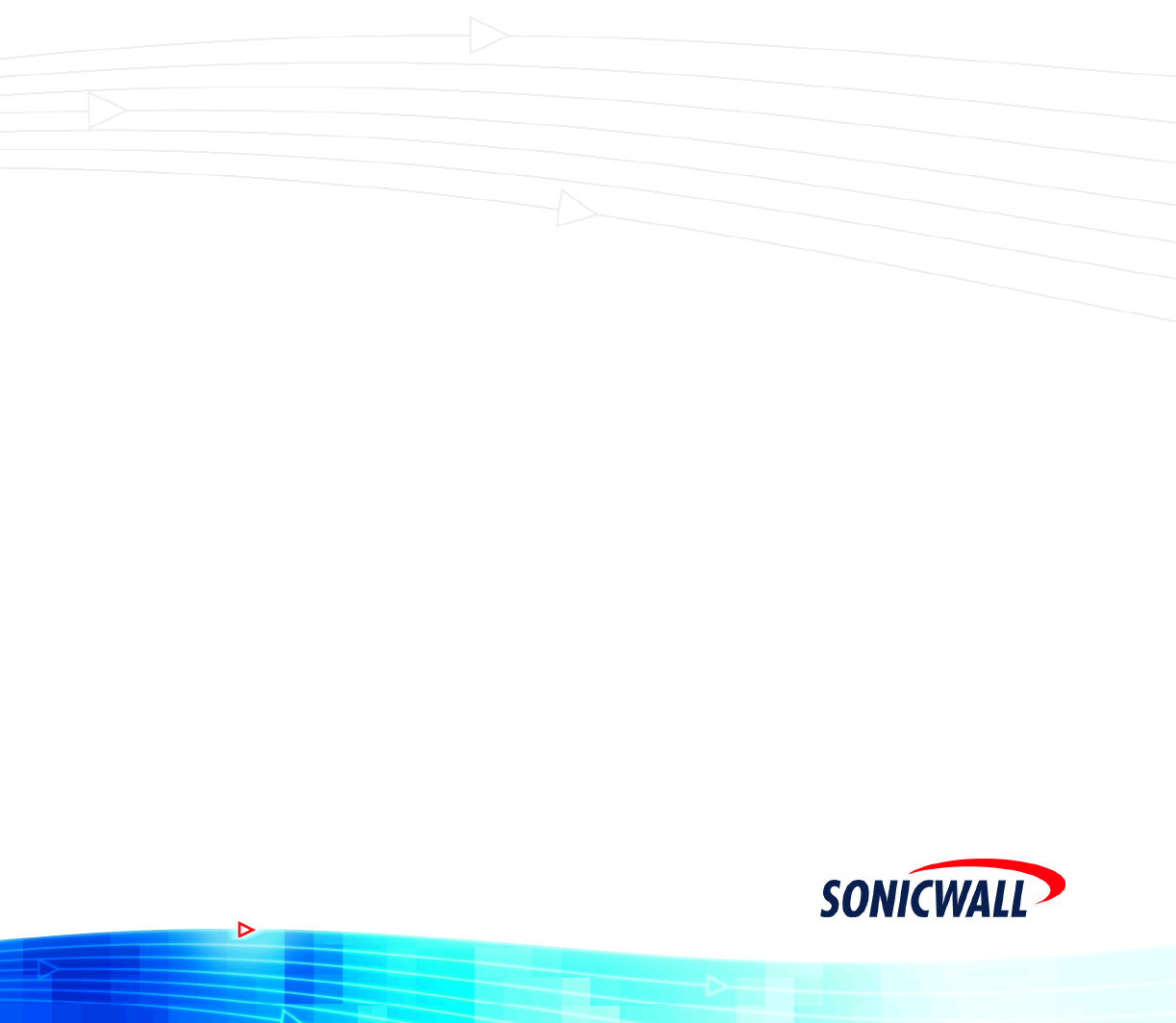
© 2002 SonicWALL, I n c . SonicWALL is a registered trademark of SonicWALL, I n c . Other product and company names mentioned herein may be
t r ademarks and/ or registered trademarks of their respective companies. Specifications and descriptions subject to change with out notice.
T: 408.745.9600
F: 408.745.9300
www.sonicwall.com
SonicWALL,Inc.
1143 Borregas Avenue
Sunnyvale,CA 94089-1306
P/ N 232- 000497- 01
Rev A 04/ 04